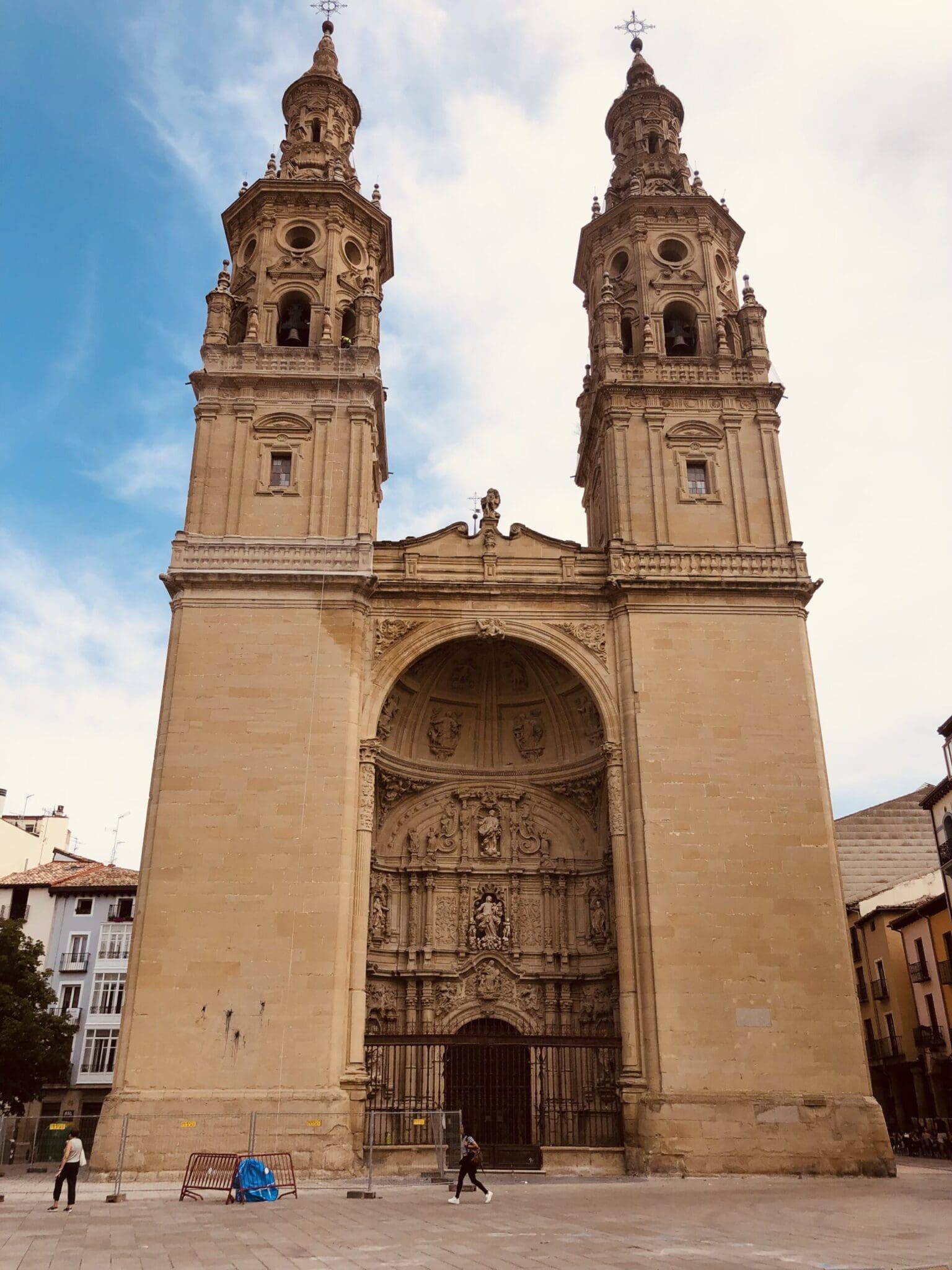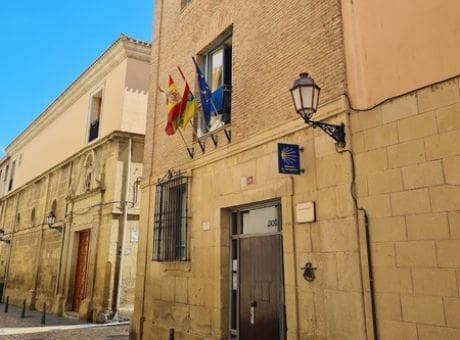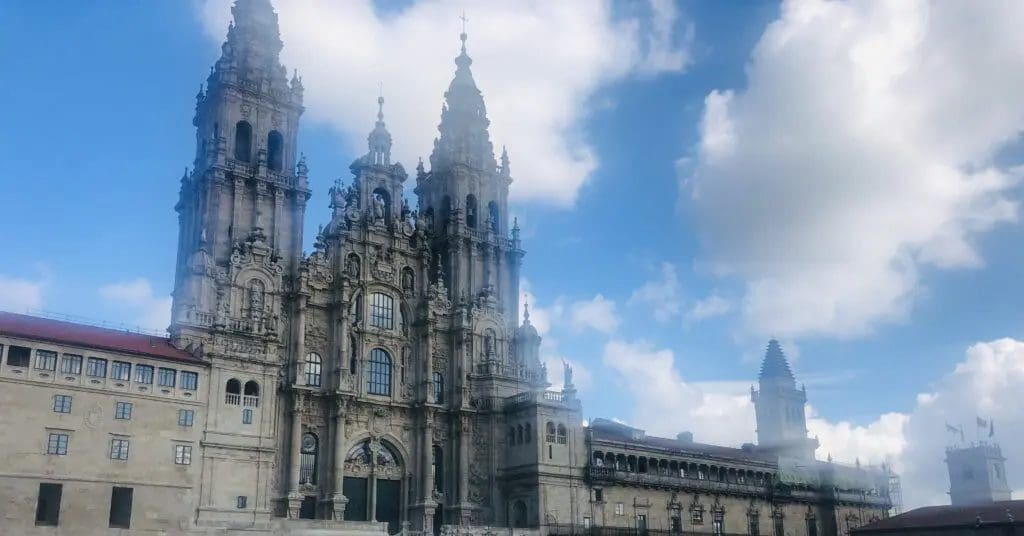Section 3
Pamplona to Logroño
This glorious stretch of the Camino takes us from Pamplona, the capital of Navarre, to Logroño, the capital of La Rioja. It’s about 95 kilometres and takes four or five days as we walk through quiet, charming villages and towns. Early on, we climb over the Hill of Forgiveness, then descend into the farmlands of Navarre and onto the vineyards of Rioja. You might get swept up in a bull run, pluck grapes as you wander through sun-drenched vineyards, pour a glass of wine from a fountain, walk on ancient Roman roads, or spend an evening in Logroño hopping between pintxo bars.

Pamplona
700.4 KM to Santiago
Like entering Pamplona, leaving it is more pleasant than some of the other cities on the Camino. You don’t pass through any industrial zones. Instead, you follow an urban path past the university campus, and then out onto a quiet road, with a broad hard shoulder for about 4 km until you reach Cizur Menor.
One bit of advice—cities can be tricky to navigate. The yellow arrows are easy to miss among all the other signs. Coming in is fine—just follow any of the signs to the city centre or cathedral. But leaving can be harder. What I usually do is pick a small village on the edge of town, turn on Google Maps with walking directions, and follow that. It will likely follow the Camino route anyway, and once you’re out of the city, the arrows are easy to pick up again.
Cizur Menor
695.6 KM to Santiago
Cizur Menor is a small modern suburban village with several bars and shops. A well-known albergue run by the Order of Malta sits at the entrance to the village, right across from the Romanesque church of San Miguel Arcángel. The Albergue is about €7 a night, and if it is full, they’ll offer you a bed inside the church. The albergue is popular with pilgrims who prefer a quieter night than what they’d find in Pamplona. I’ve never stayed there myself. Pamplona’s energy has always pulled me in, but hopefully I will get to stay here next time.

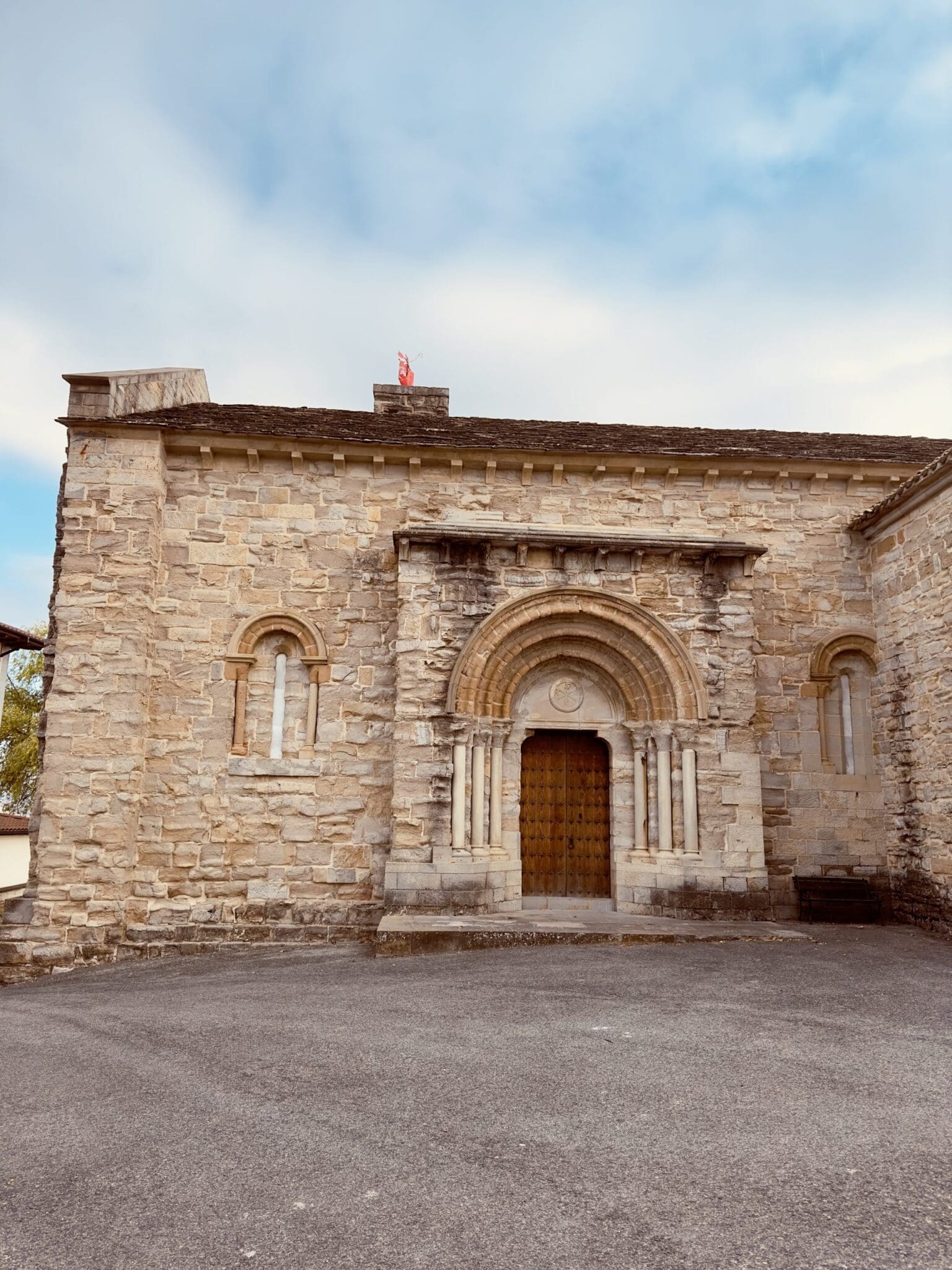
Zariquiegui
689.5 KM to Santiago
After Cizur Menor, the countryside unfolds once more. The path turns to track again, and you begin a steady climb. It starts out gently, leading up to the small hamlet of Zariquiegui. There’s a simple Romanesque church and a little shop that sells ice cream—well worth a stop.
There’s also a small private albergue above the shop—Albergue San Andrés. It looks simple and charming. A good spot if you want somewhere quiet. Perfect if you plan to set out early and catch the sunrise over Alto del Perdón.
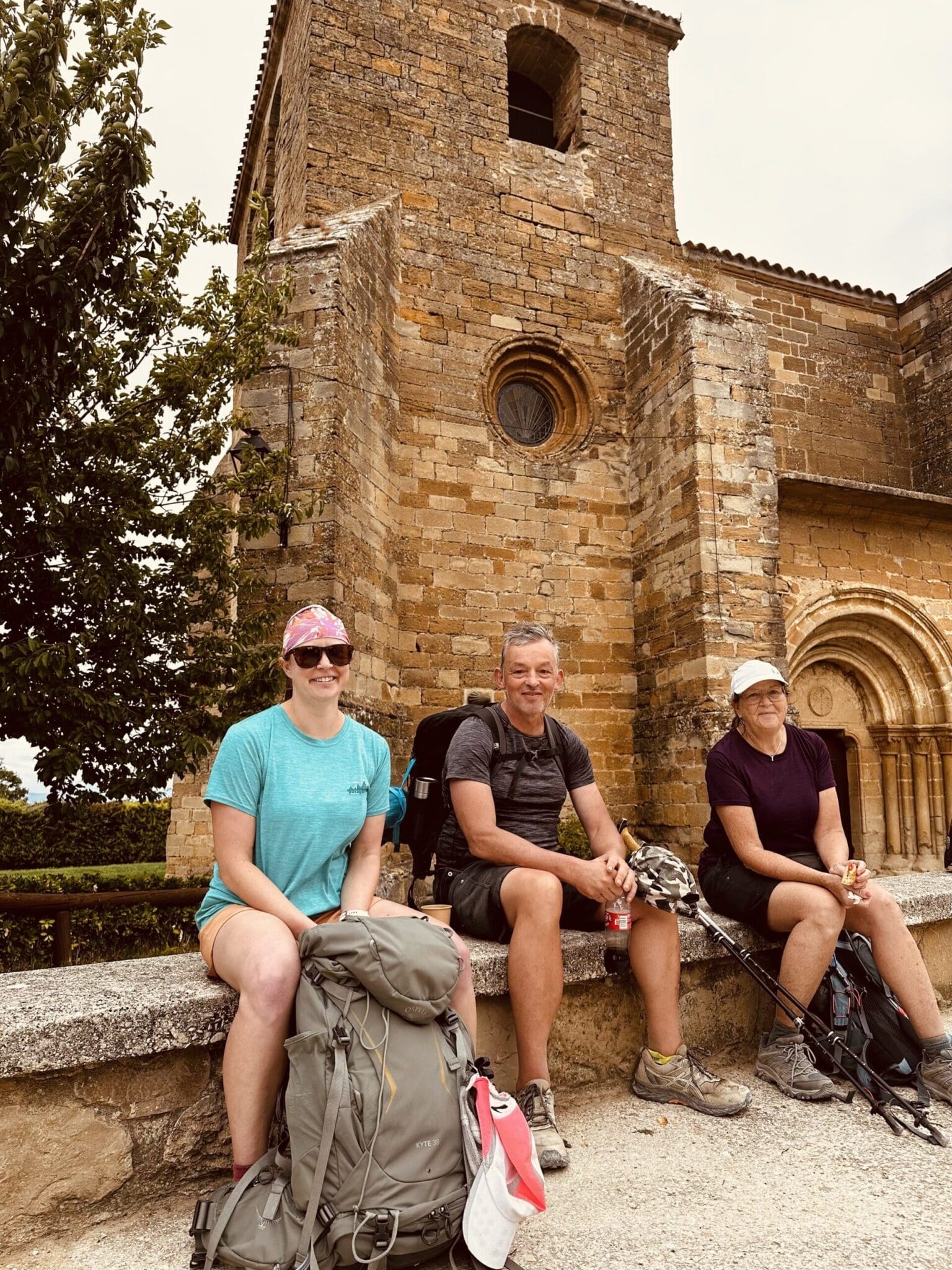
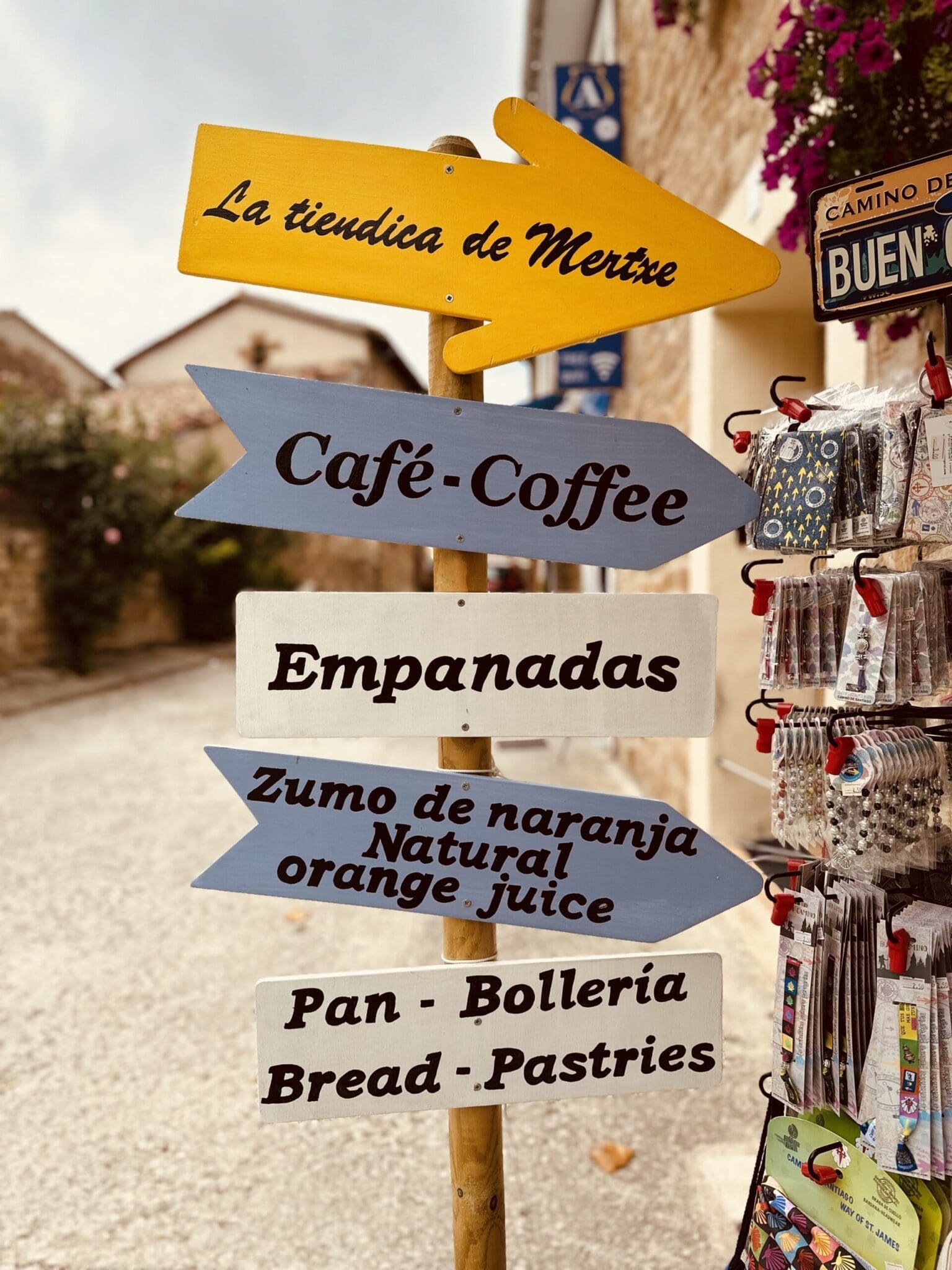
By now, you’ve probably noticed my frequent references to The Way. Eagle-eyed fans might recognize Zariquiegui as the spot where Joost and Sarah first meet. She’s sitting on the wall of the church, smoking, when he walks up.
Alto Perdon
687.1 KM to Santiago
From the village, the path narrows and becomes steeper. Continue up. I once had a family of wild boar pass right in front of me, mother, father, and the young ones—moving nonchalantly across the track. They didn’t pay me any attention, just kept moving along.
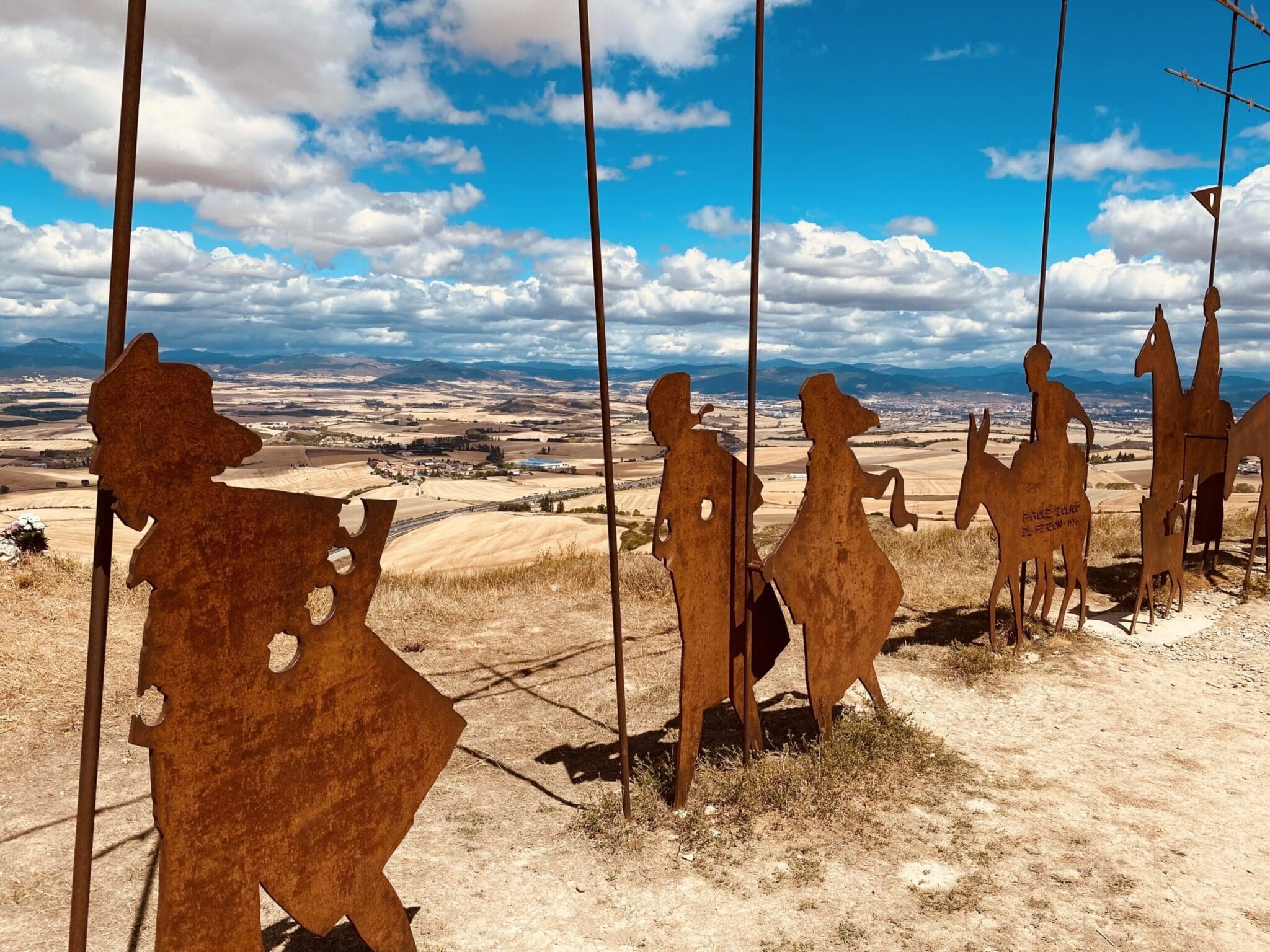
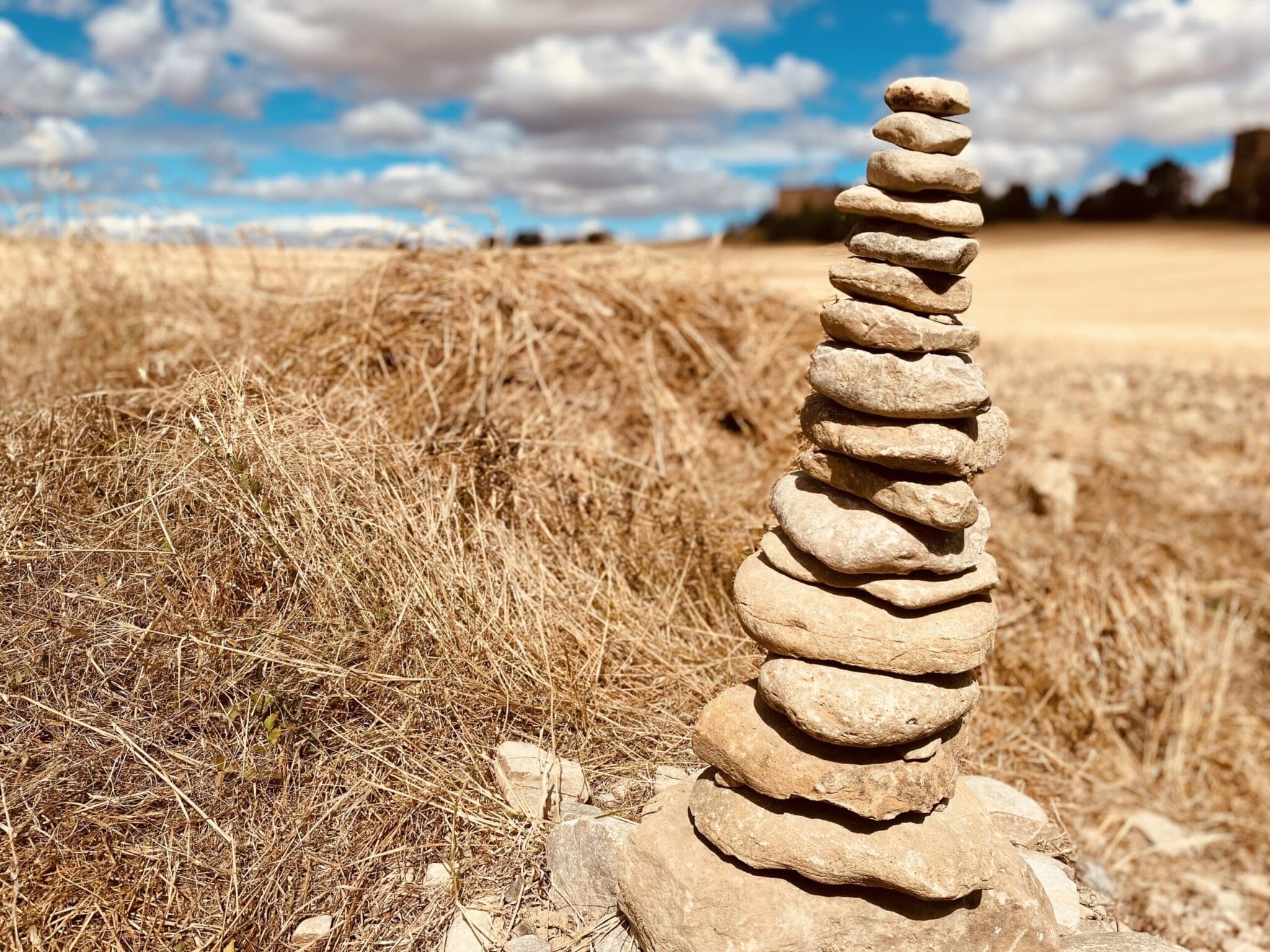
As you climb, the views back over Pamplona are epic. After about 30 minutes, you will reach the top of Alto del Perdón—the Hill of Forgiveness. At the summit stands the striking metal sculpture of pilgrims walking through time. Monumento al Peregrino is life-size, modern, and unforgettable. Installed in the 1990s, it’s one of the most photographed spots on the Camino. The inscription reads: “Where the path of the wind meets the path of the stars.”
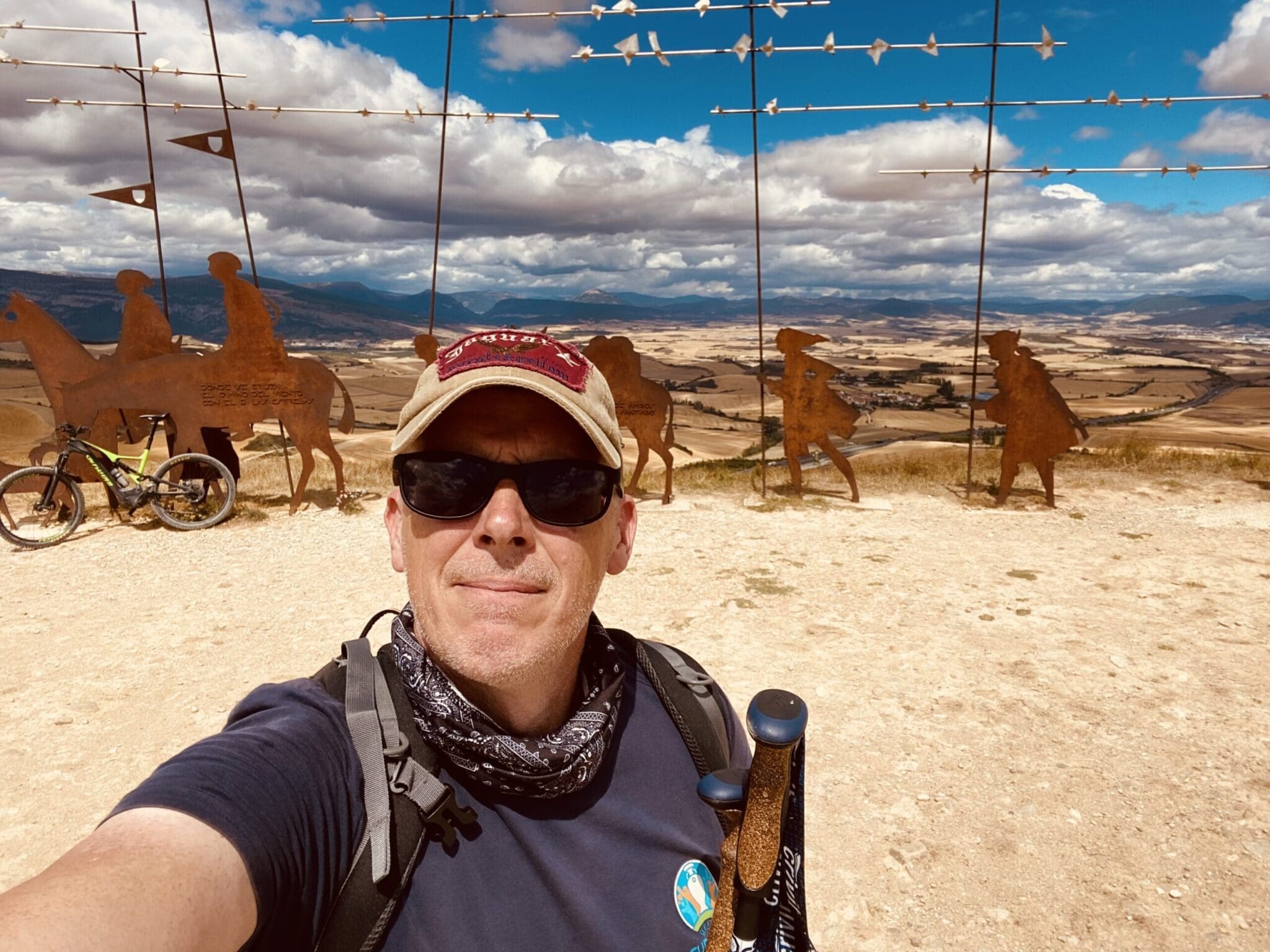
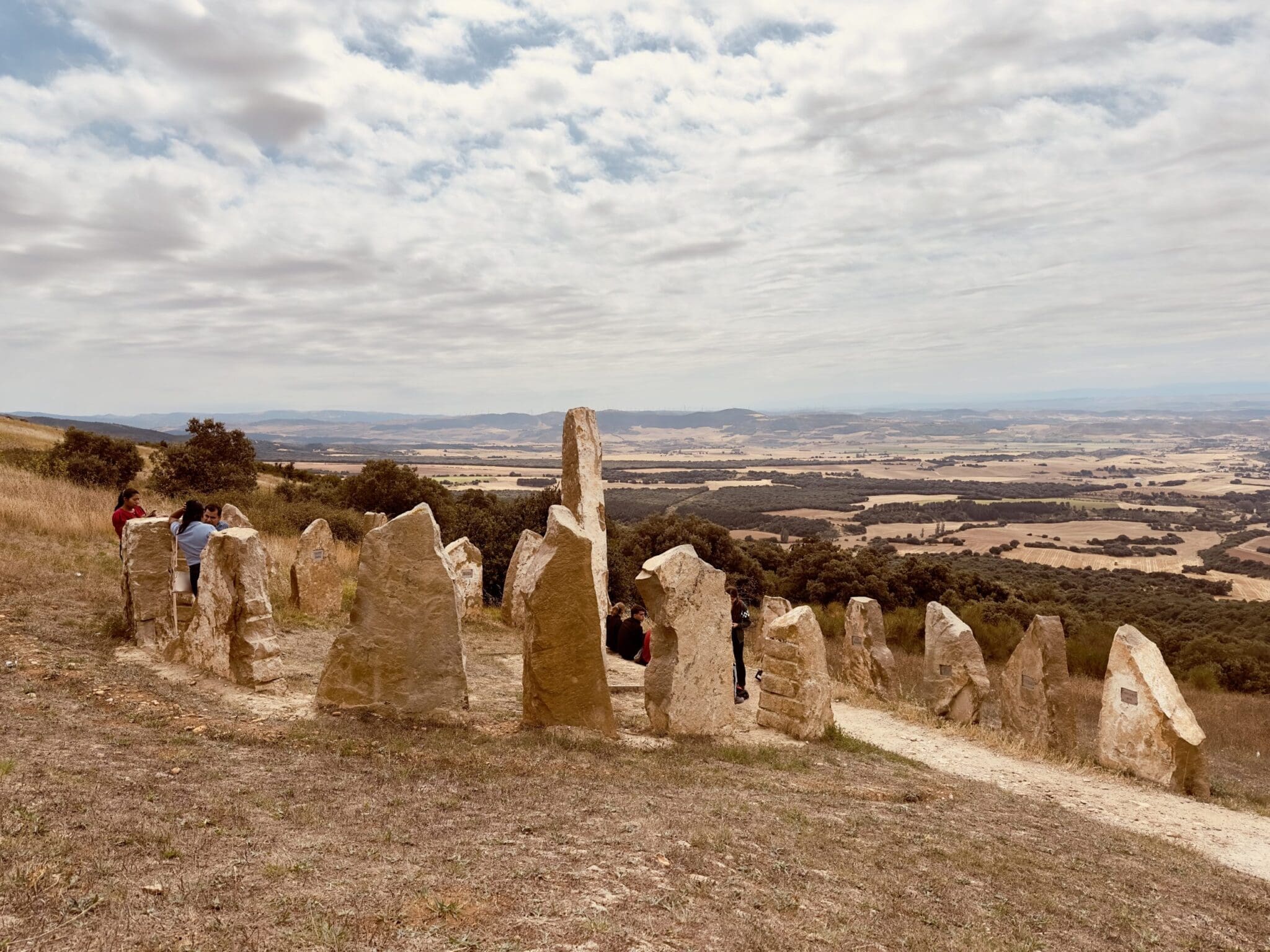
There is also a monument of standing stones dedicated to victims of the Spanish Civil War from the local area, its worth stopping here for a moment of reflection before you start your descent.
Utegra
679.1 KM to Santiago
The hike down from Alto del Perdón is treacherous—steep, rocky, and hard on the knees. Take your time. After about an hour, the trail flattens out and runs through almond groves and wheat fields.
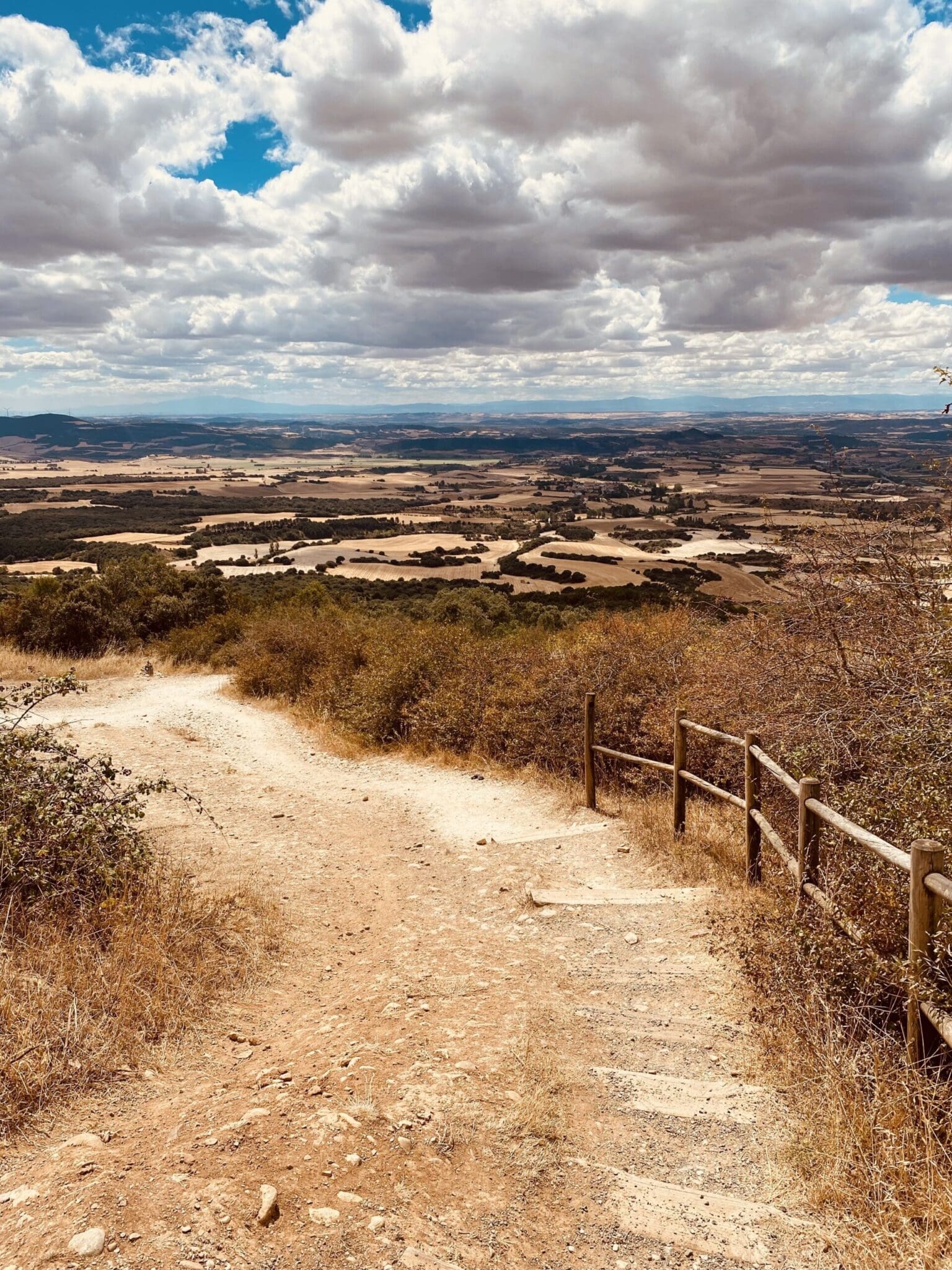
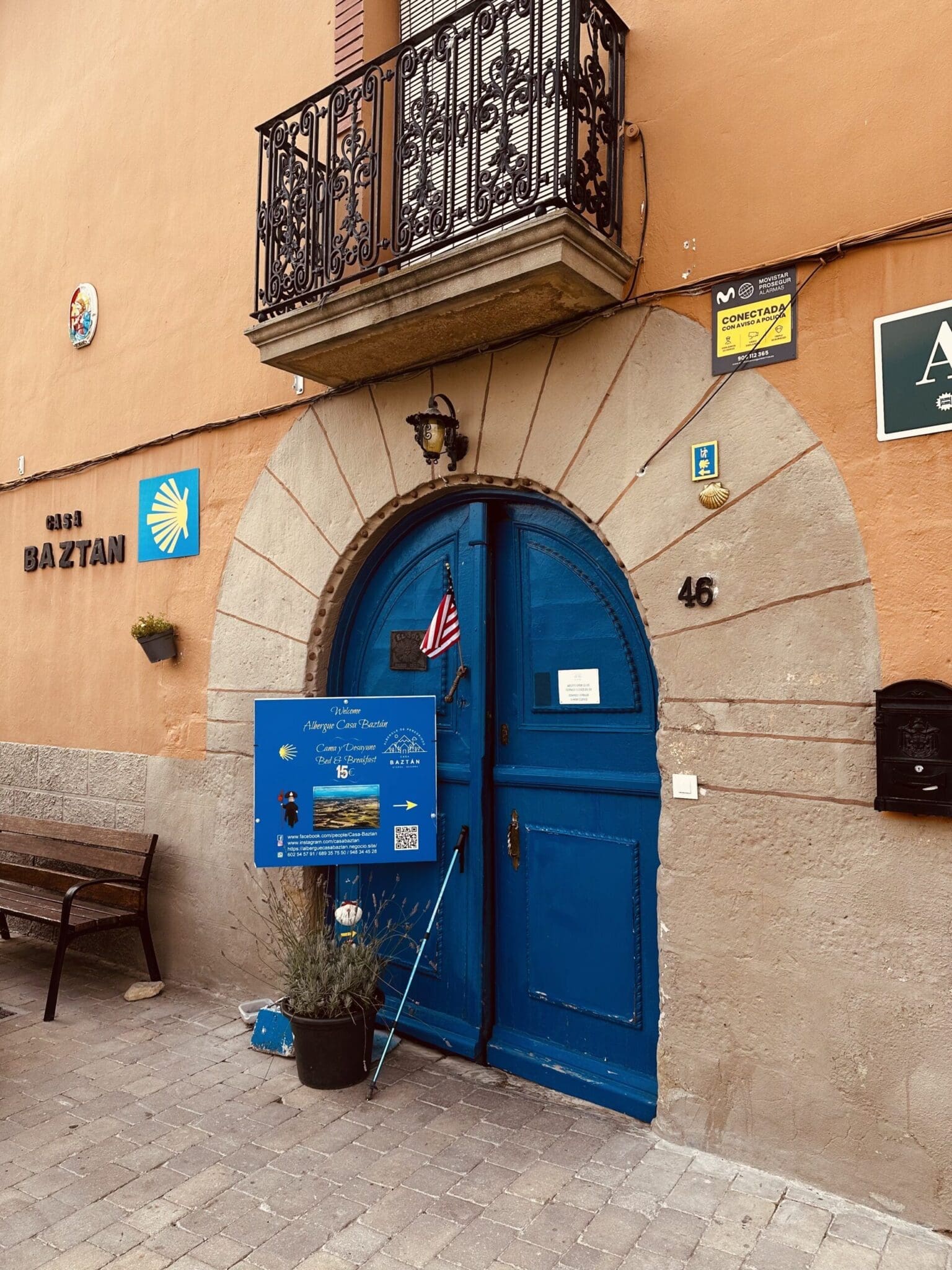
I always get a strange feeling at this point—like I’ve finally crossed into Spain. I don’t know why. Maybe it’s the warmth; this stretch has its own microclimate. Maybe it’s the smell of the almond trees. But something changes. Something settles. It feels like Spain proper now. After a couple of kilometres, you reach the small village of Uterga, where you’ll find a few albergues and a cafe.
Eunate
683.6 KM to Santiago
Continue toward Muruzábal, where the path splits. You can go straight to Obanos, about 2 km ahead, or take the detour left to the chapel of Santa María de Eunate. I’d say 100%, go to Eunate.
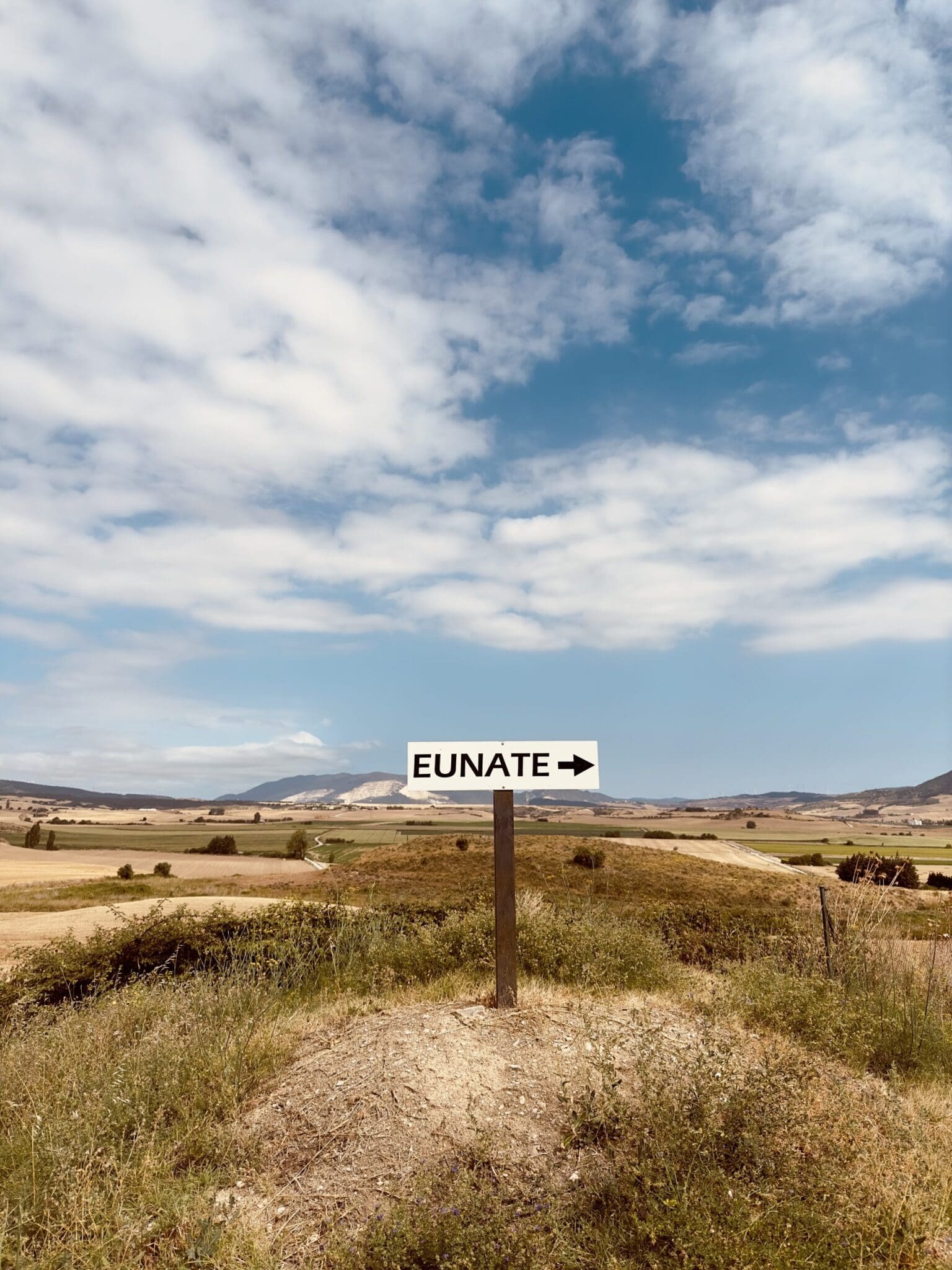
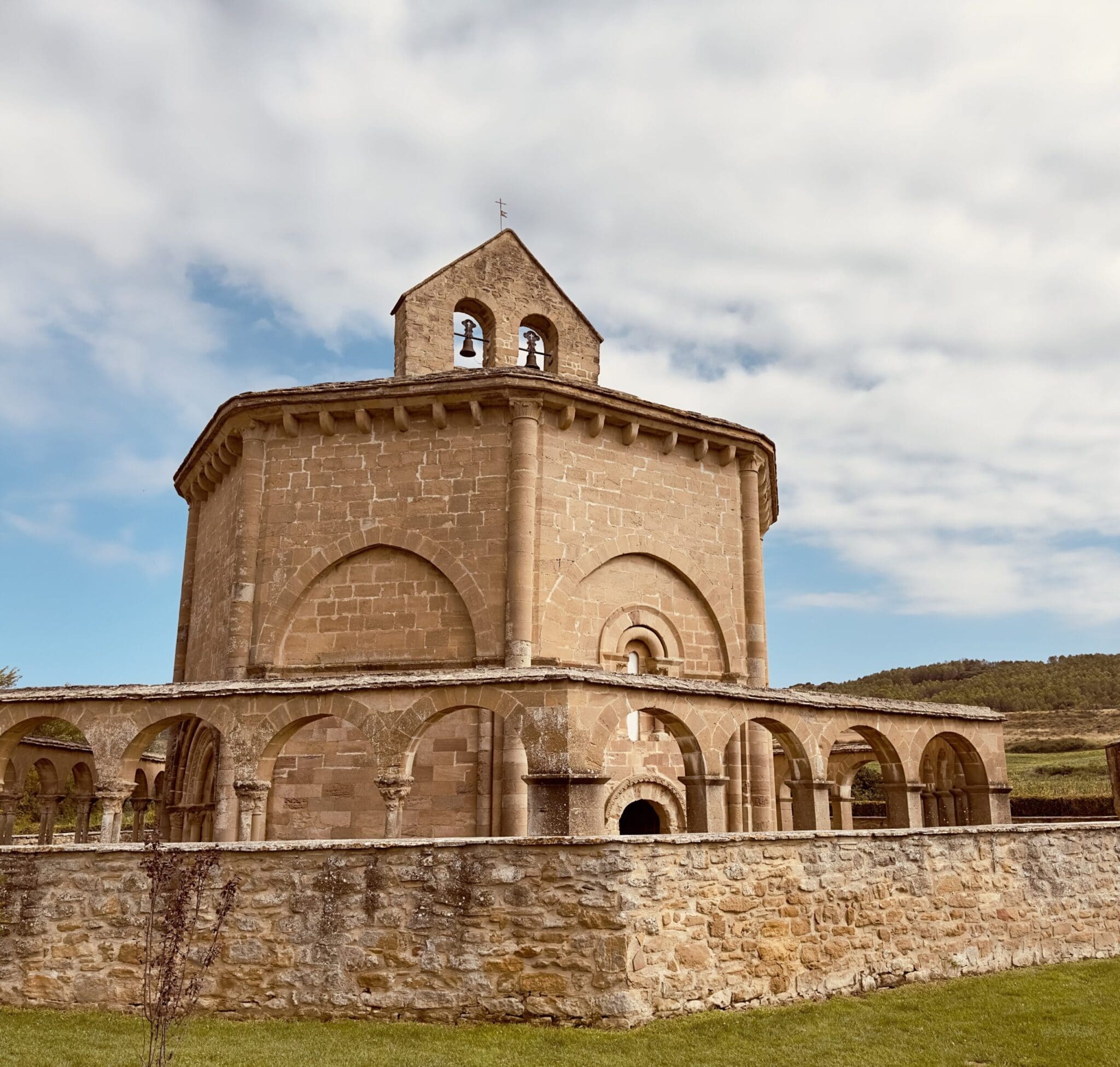
The walk there is quiet. Empty roads. You likely won’t see anyone. The Romanesque churh is incredible, built around 1170, and said to be linked to the Templars. It’s full of symbolism. Thirty-three arches. A hundred doors. Eight sides. Sacred numbers for Christians, Jews, and Muslims alike. Enough material to base a whole Dan Brown novel on.
Take your time. You might have it all to yourself. It’s one of my favourite places on the Camino. The walk back to rejoin the main trail is just as good. Late afternoon light, maybe just you and the butterflies.
Obanos
683.6 KM to Santiago
After a few kilometres of quiet walking, the detour to Eunate rejoins the main path again at Obanos. There’s a fine church here, Iglesia de San Juan Bautista. You’ll hear many legends along the Camino, and this is one of them.
Guillermo, a duke from Aquitaine, walked to Santiago with his sister, Felicia. When they returned, she chose a religious life and went into seclusion. Angry that she turned away from the royal life, he killed her. But the guilt hit him hard. He made another pilgrimage to Santiago. When he returned, he gave up everything and became a hermit in Obanos. He’s buried in the church.
Puente La Reina
676.6 KM to Santiago
Continue on for another 2km to Puente la Reina—the Bridge of the Queen. A classic Camino town, and a popular place to stop for the night.
The town has everything you need—bars, restaurants, shops, and plenty of places to stay. As you enter, you’ll see Hotel Jakue on the right. A little further on the left is the municipal albergue—Albergue de los Peregrinos. Also, if you keep going through the town, cross the bridge for which the town is named, and take a right, you’ll find a popular albergue there with a swimming pool. It’s a great spot in summer.
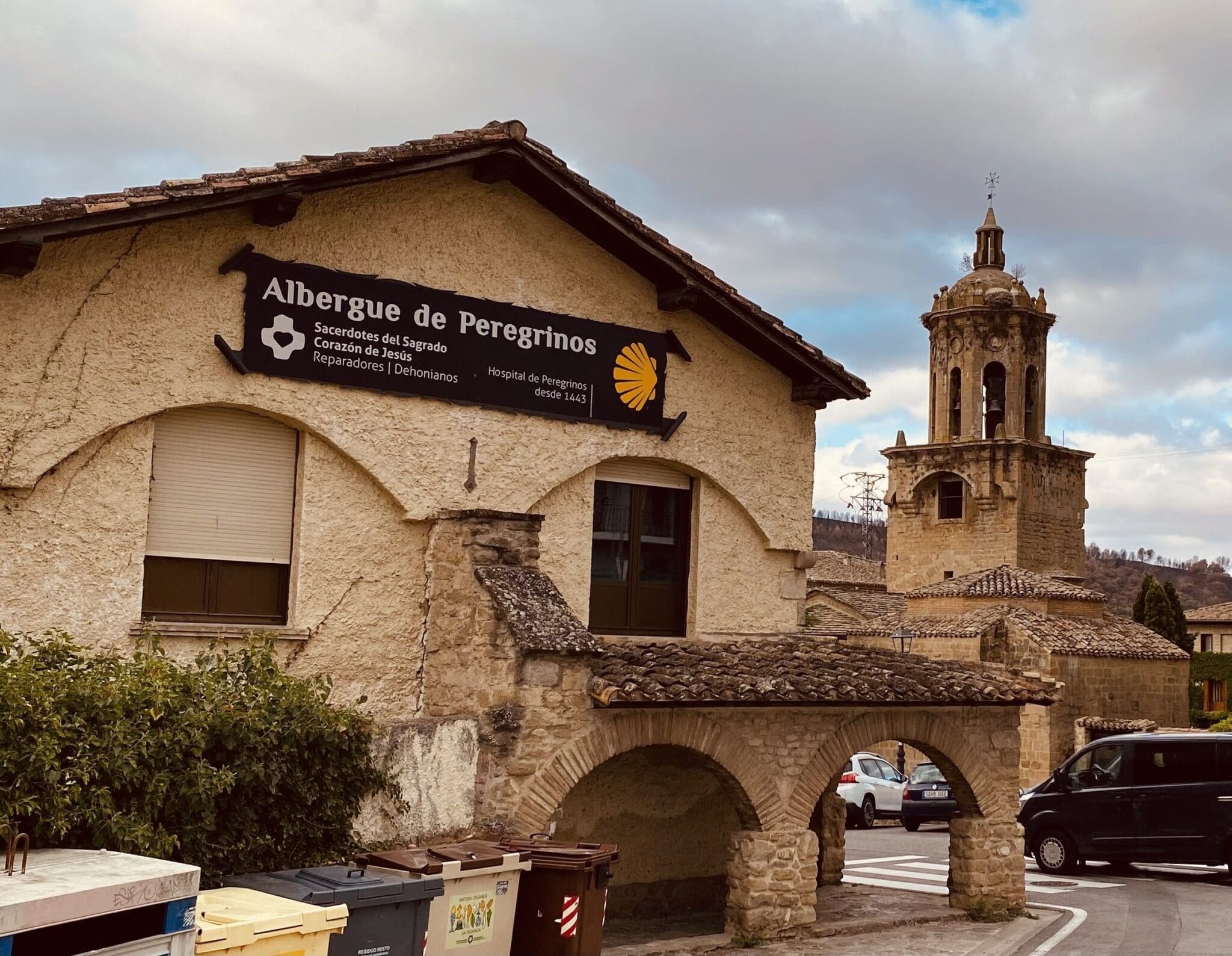
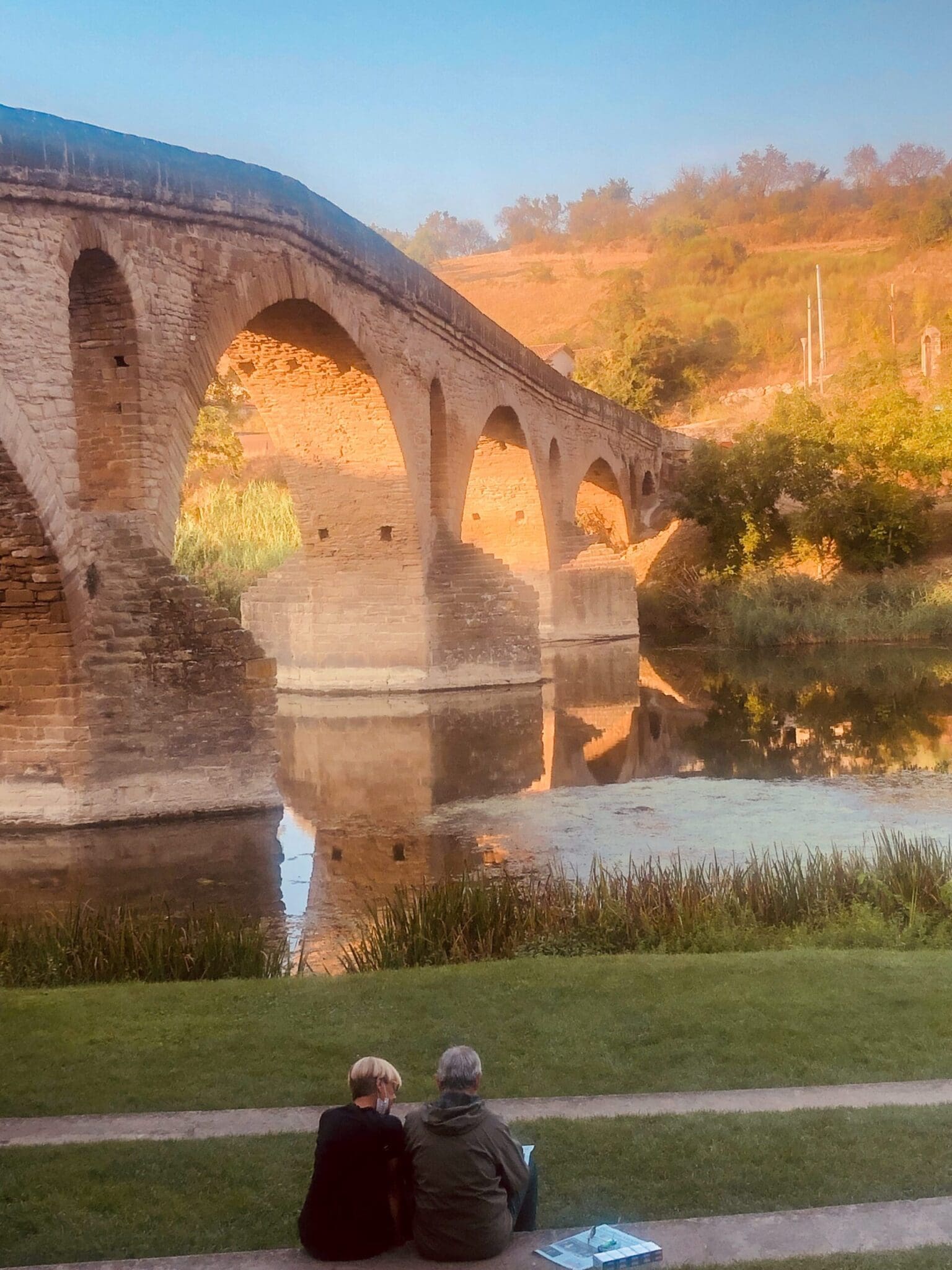
While you’re in town, stop into the Iglesia de Santiago. It’s just past the municipal albergue on the right. It’s worth a look. After that, find a spot on the main street for lunch or dinner, outdoor tables are busy with pilgrims and locals. It’s a bit chaotic, but great energy.
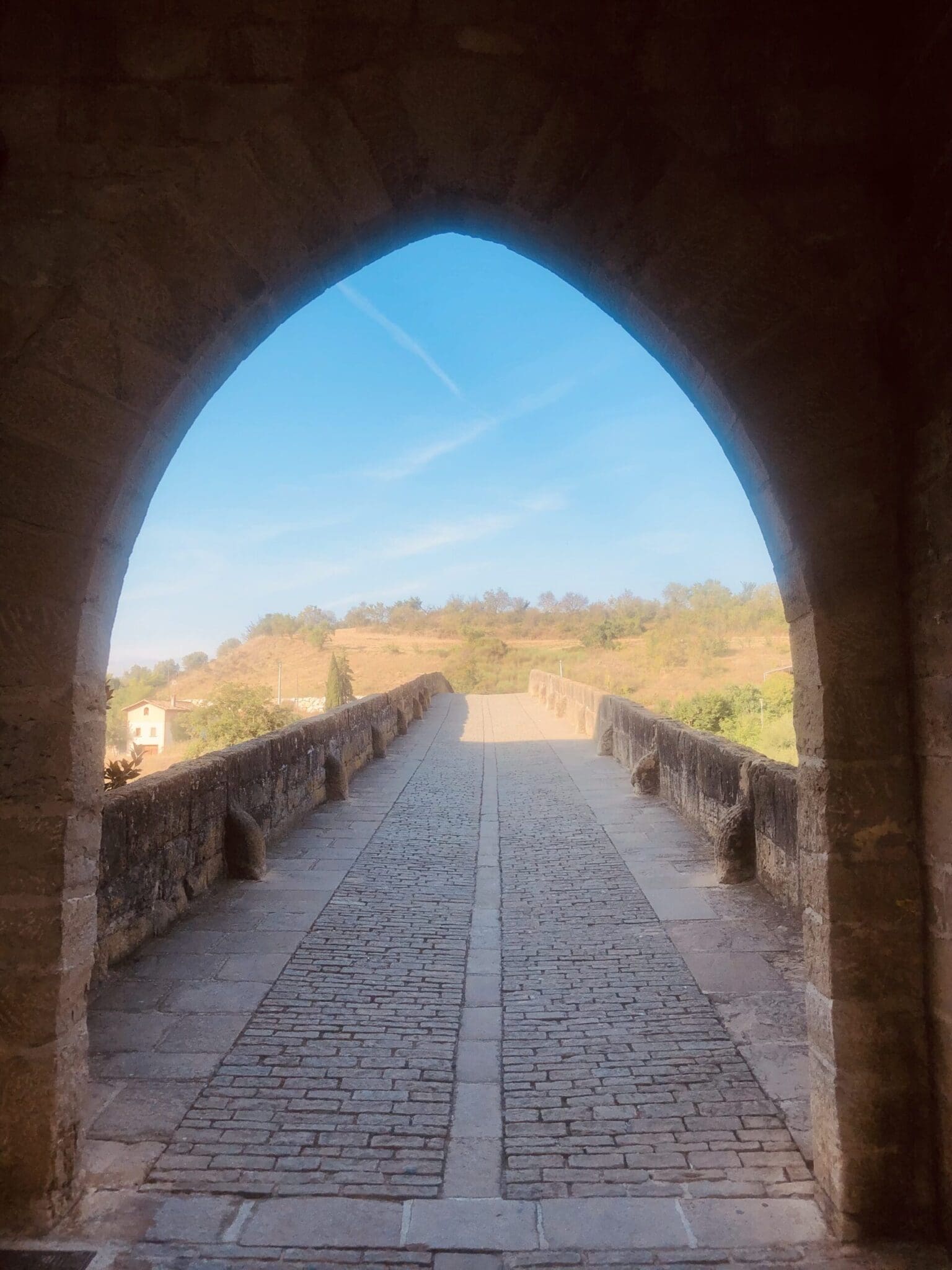
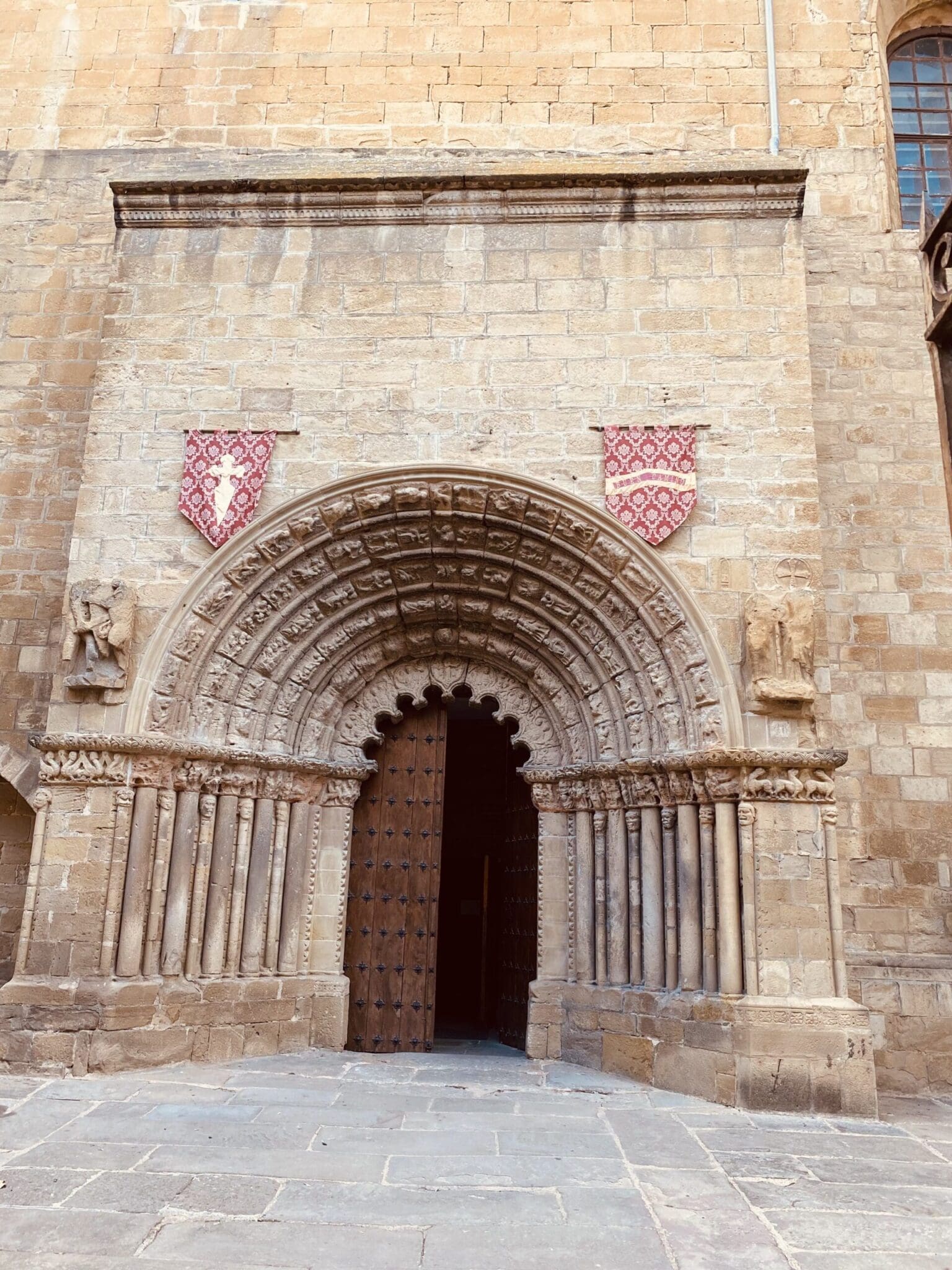
Many of the villages and towns along the next stretch hold traditional bull-running events, called encierros. These usually involve young bulls or cows (vaquillas) running through the streets. It’s not Pamplona, but they have great local charm. In Puente la Reina, the encierros happen every year from July 24th to 30th, during the feast of Santiago. They also run again on the last weekend of September.
Finally, yes, if you’re thinking of The Way, this might look like the bridge where Tom loses his backpack. But that scene was filmed off the Camino. Still, this bridge is the real deal—stone, medieval, beautiful.
Cirauqui
668.8 KM to Santiago
Leave Puente la Reina over its famed bridge and take a left after crossing. Follow the waymarks out of town. The Camino turns back to dirt track, winding through gentle hills and open fields.
After about 5 kilometres, skirt around the small village of Mañeru. There’s one albergue here. Continue on, the path stays rural, lined with olive trees, vines, and wheat fields. It’s one of the prettiest stretches on the Camino.
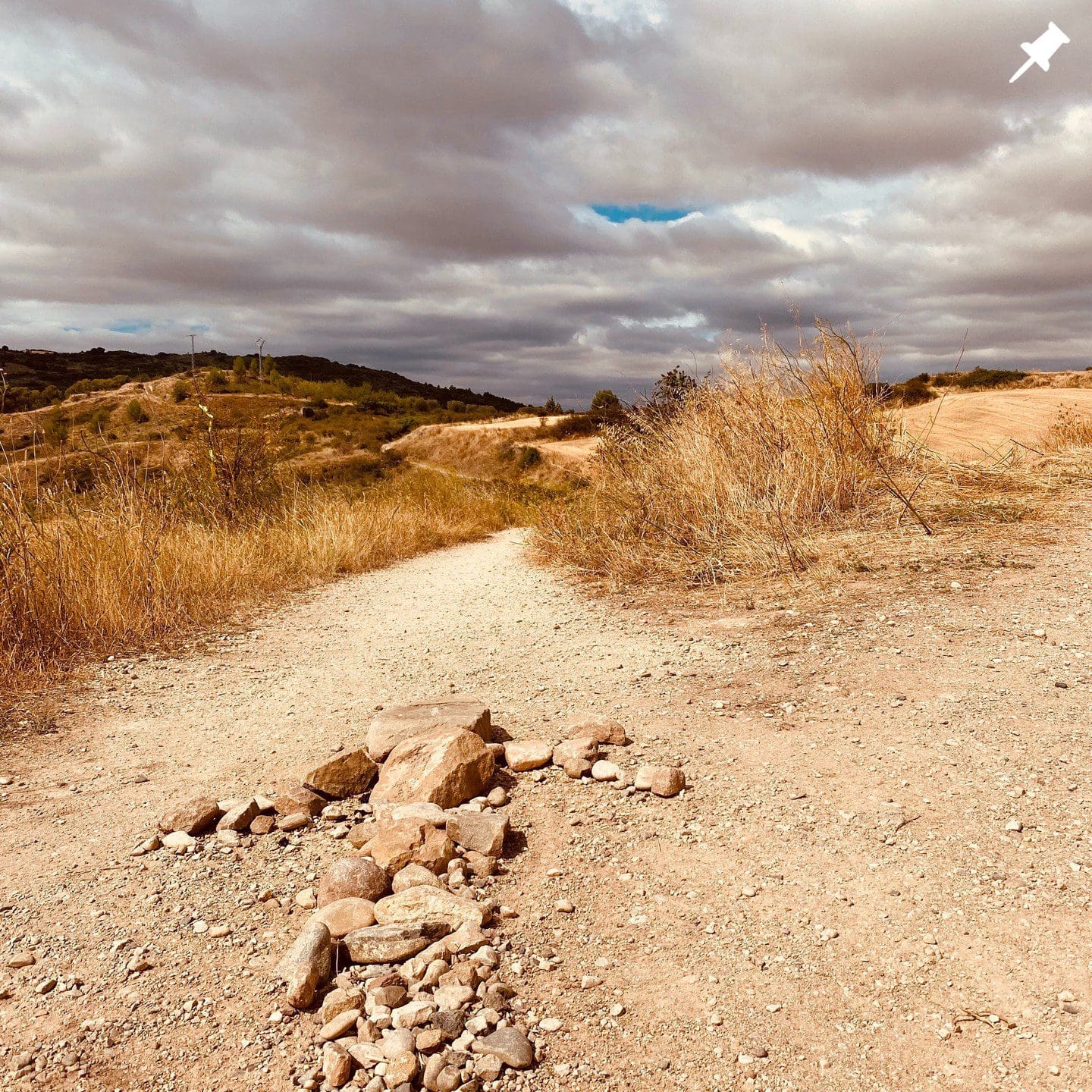
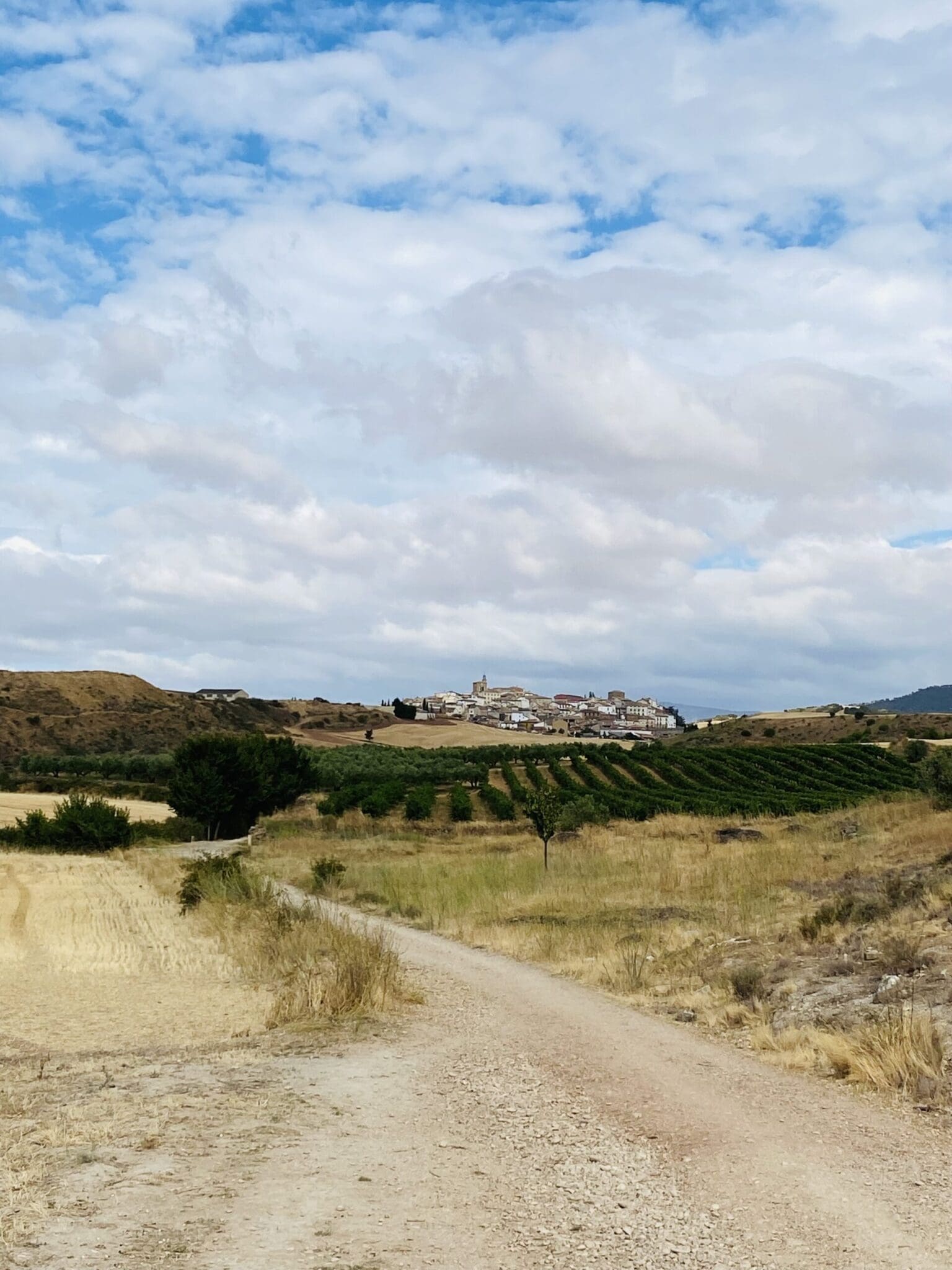
Ahead, Cirauqui rises on a hilltop, wrapped in vineyards. It’s postcard stuff—stunning. As you climb toward the village, you’ll find yourself walking on a Roman road more than 2,000 years old. Time to pinch yourself.
The town’s old Basque name means “nest of vipers,” and the Codex Calixtinus once warned pilgrims to avoid it. But today, it’s one of the most charming spots on the route.
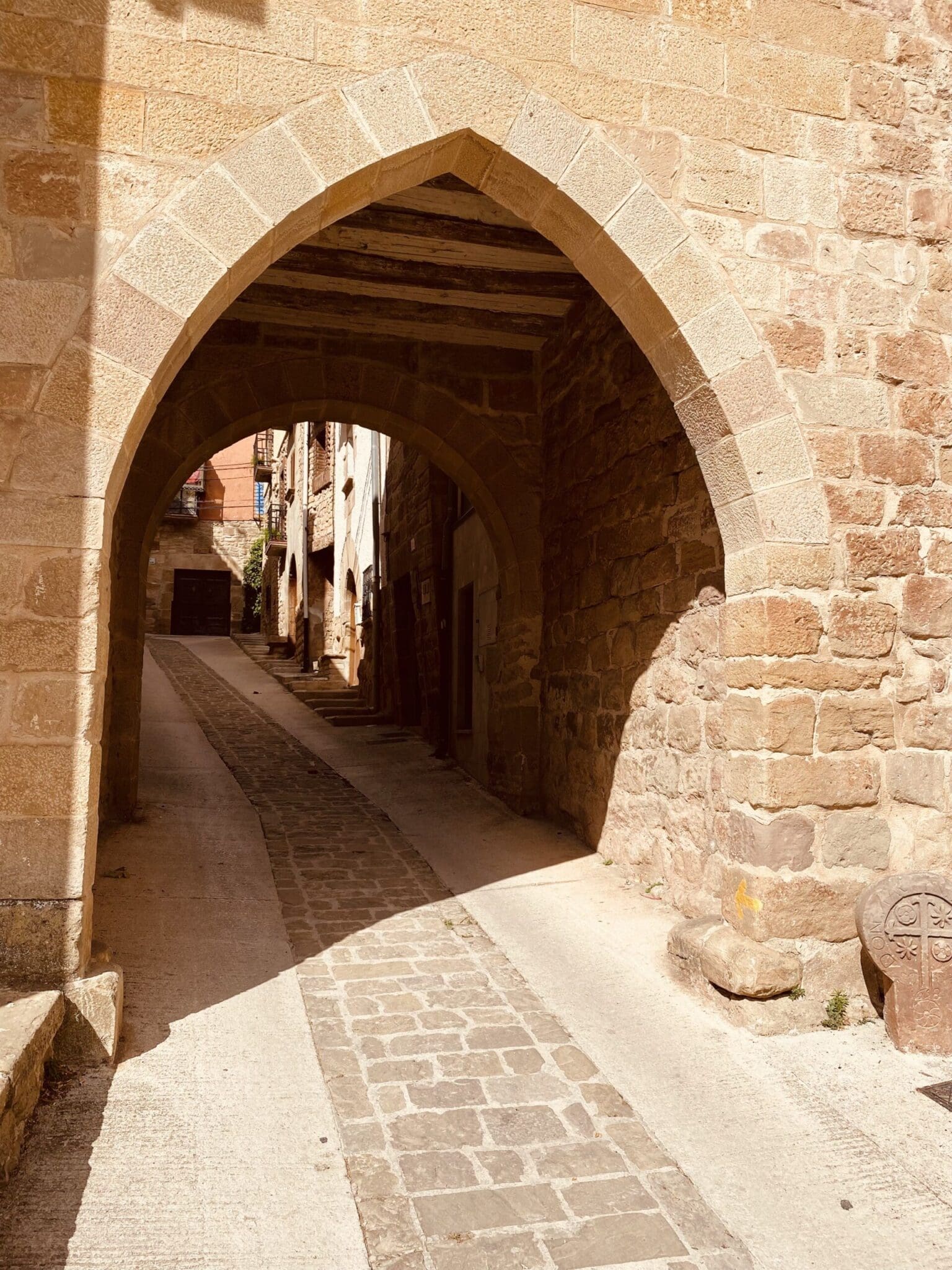
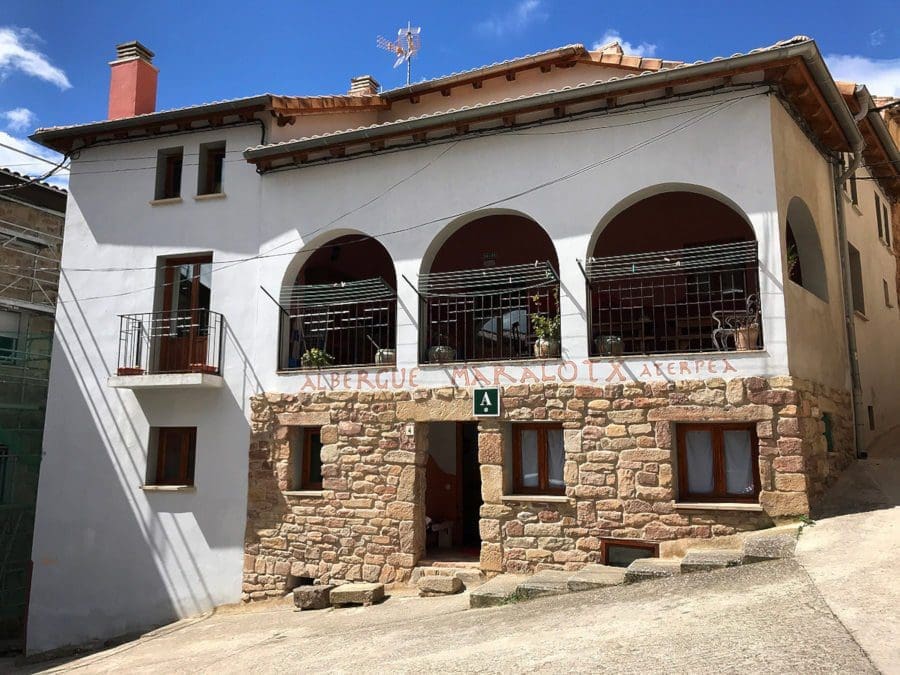
Cirauqui is also home to one of my favourite albergues on the Camino—Casa Maralotx. The name curiously means “bad blacksmith”. It’s best known for its communal dinner, served in a medieval stone cellar. The food is honest and straightforward—things like fresh salad, chickpea stew, and dessert. It all comes with plenty of local wine.
This place is really special. It sets the bar high for other albergues. I would definitely bookmark this one and reserve well in advance.
Lorca
668.8 KM to Santiago
From here, the Camino continues on an old Roman road. It rises and falls all the way to Lorca. You’ll cross a surviving Roman bridge—2,000 years of history under your feet. Soak it in as you walk.
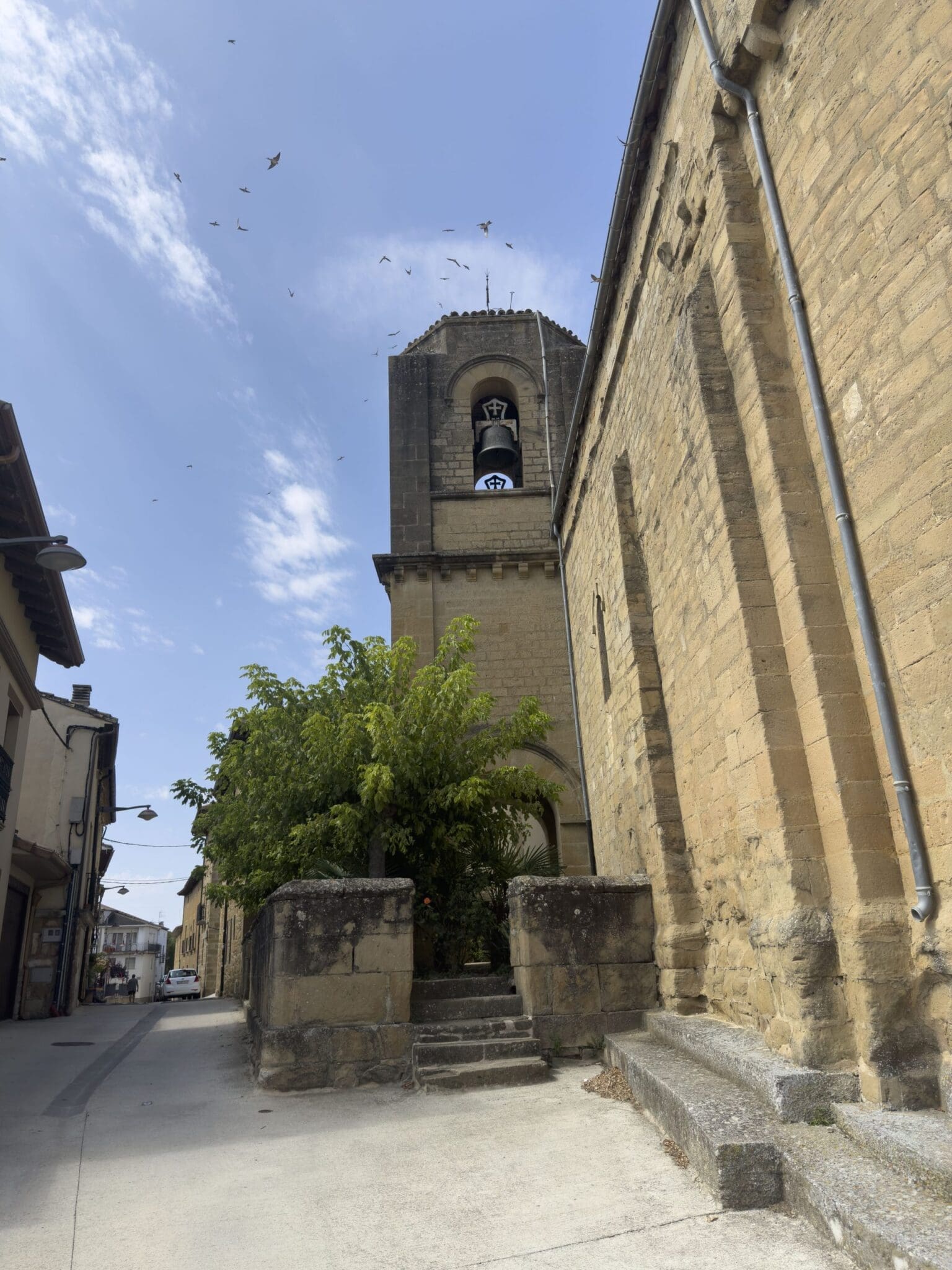
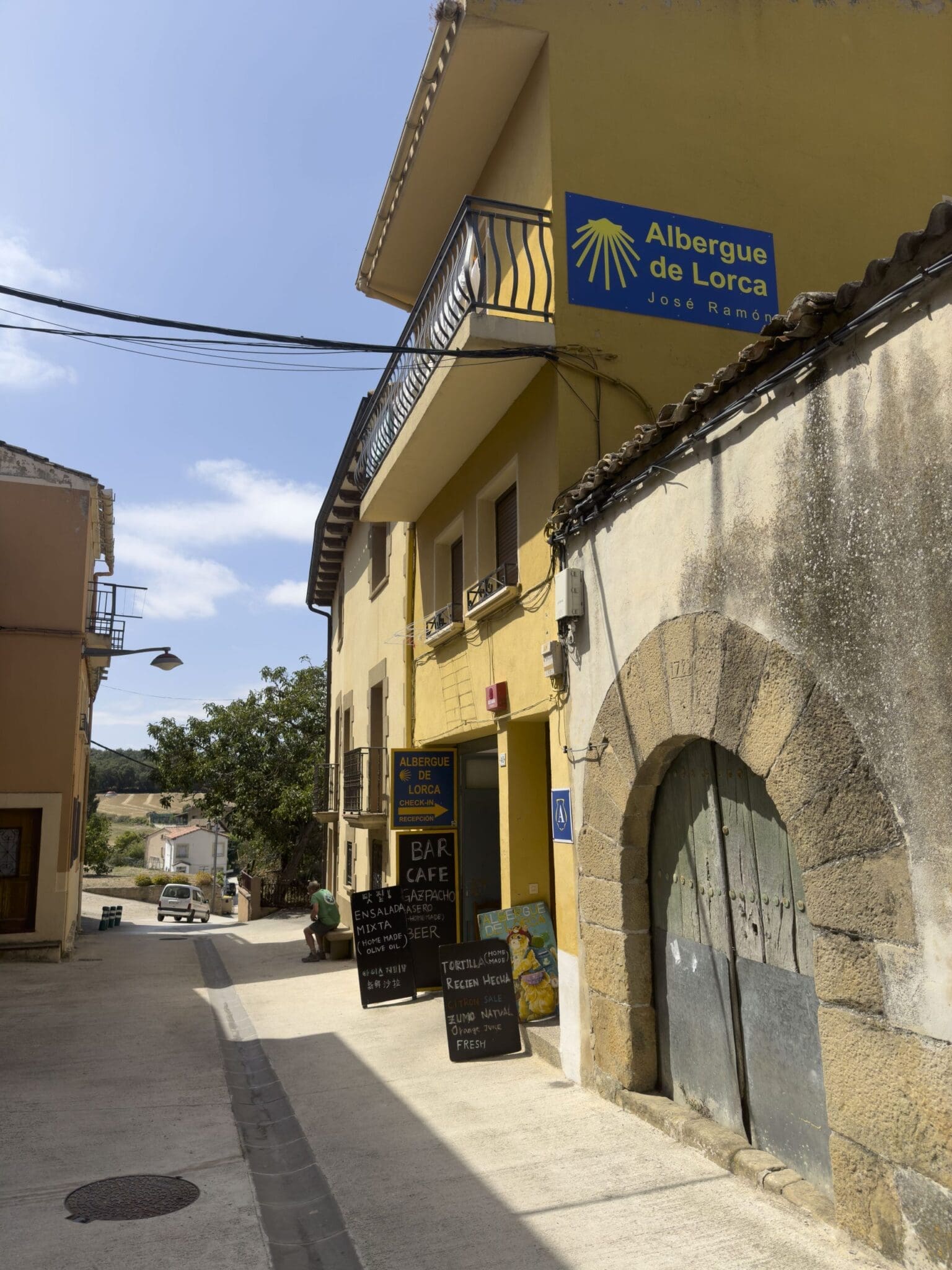
Lorca sits on a small hill, facing the open valley toward Estella. It’s a tranquil place, good for a peaceful evening. There are a couple of albergues and a café in Albergue La Bodega del Camino.
Villatuerta
668.8 KM to Santiago
The walk from Lorca to Estella is about 12 kilometres. The trail rolls gently through farmland, olive groves, and open country. You pass through a few small villages—Villatuerta and Ayegui. There is a wonderful albergue in Villatuerta, which puts the place on the map, Albergue La Casa Mágica. It is definitely another albergue that I would bookmark.
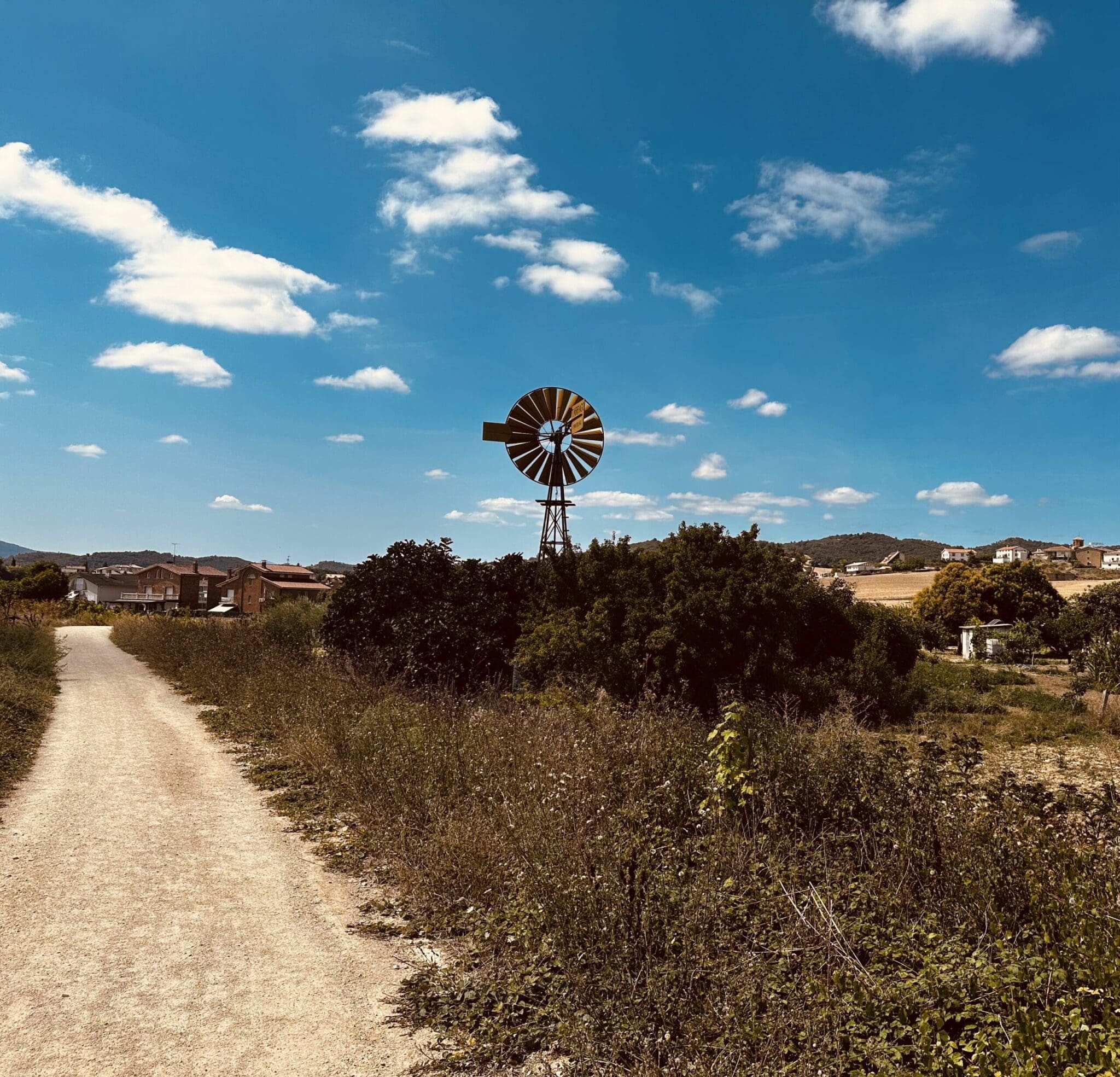
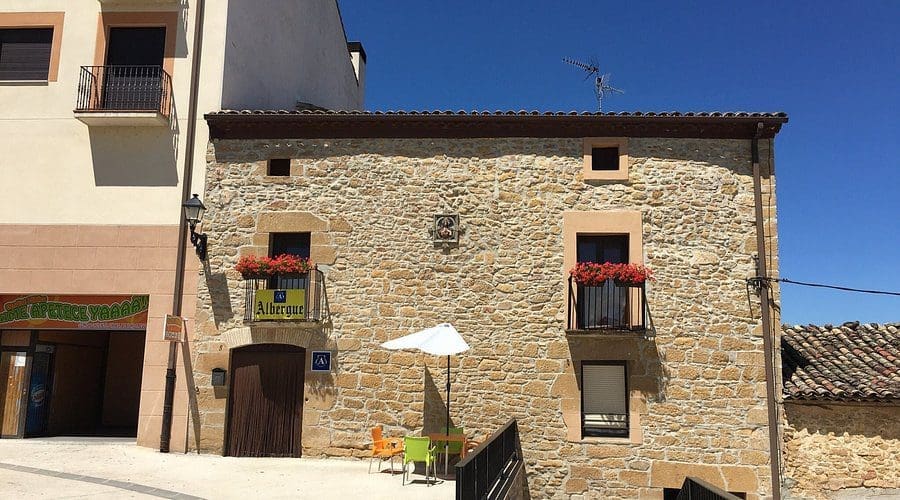
Estella
654.9 KM to Santiago
Continue walking, and Estella comes into view—sudden and sharp. Estella is a proper town with shops, cafés, bakeries, and all the buzz that comes with it. After the quiet of the countryside, it feels like you’re back in the busy world again.
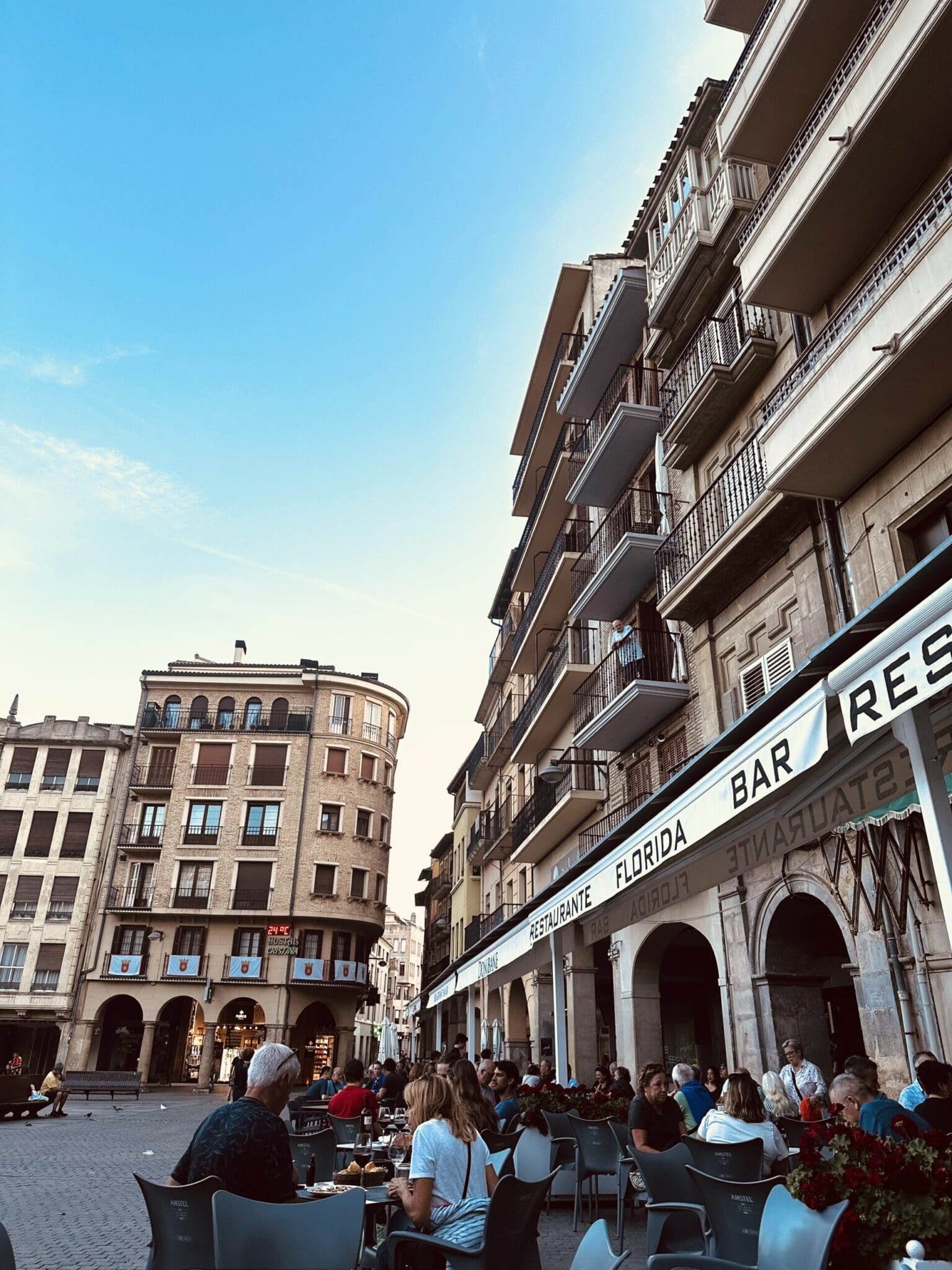
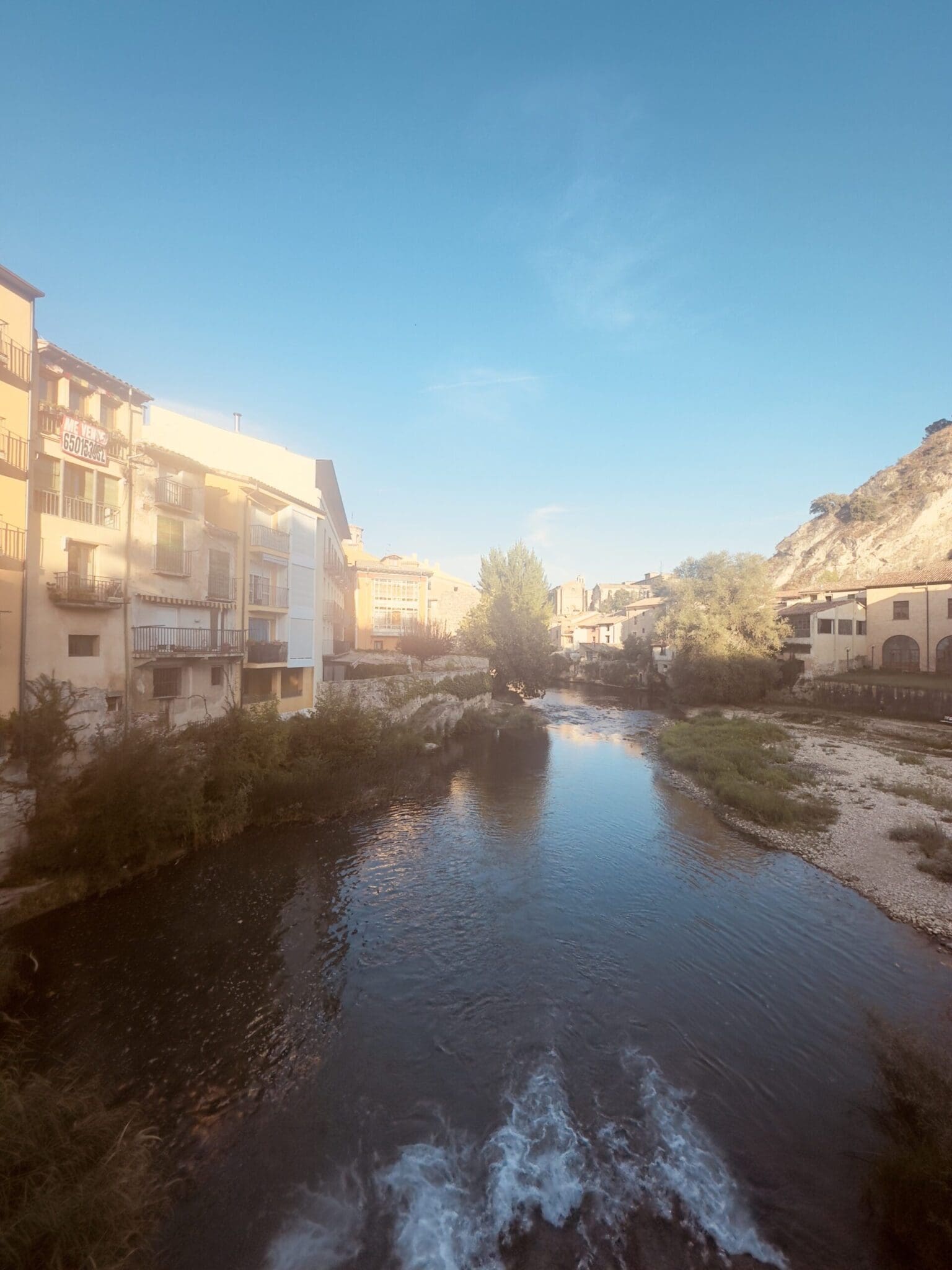
The town sits on the fast-flowing Ega River, with stone bridges and narrow lanes that twist through old buildings. There are plenty of albergues to choose from. The municipal is central and reliable. Agora is modern. A Santiago is smaller but friendly.
Estella’s churches are also worth a look. Iglesia de San Pedro de la Rúa sits above the town with a fine cloister and good views. Iglesia del Santo Sepulcro has a striking Gothic façade. You’re walking through real history here, and it’s easy to feel it. Estella is a good place to rest, eat well, and take it all in before the road calls again.
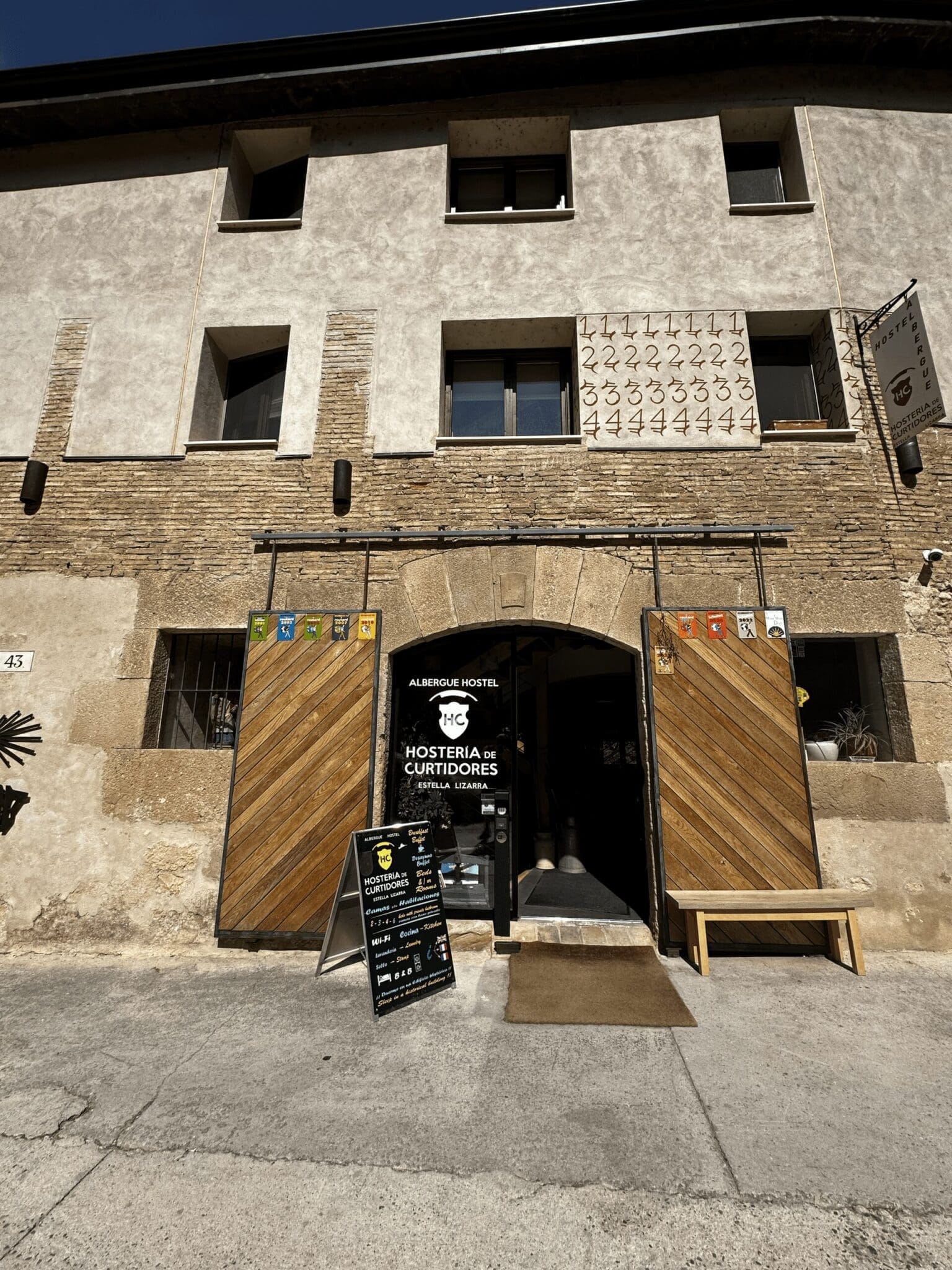
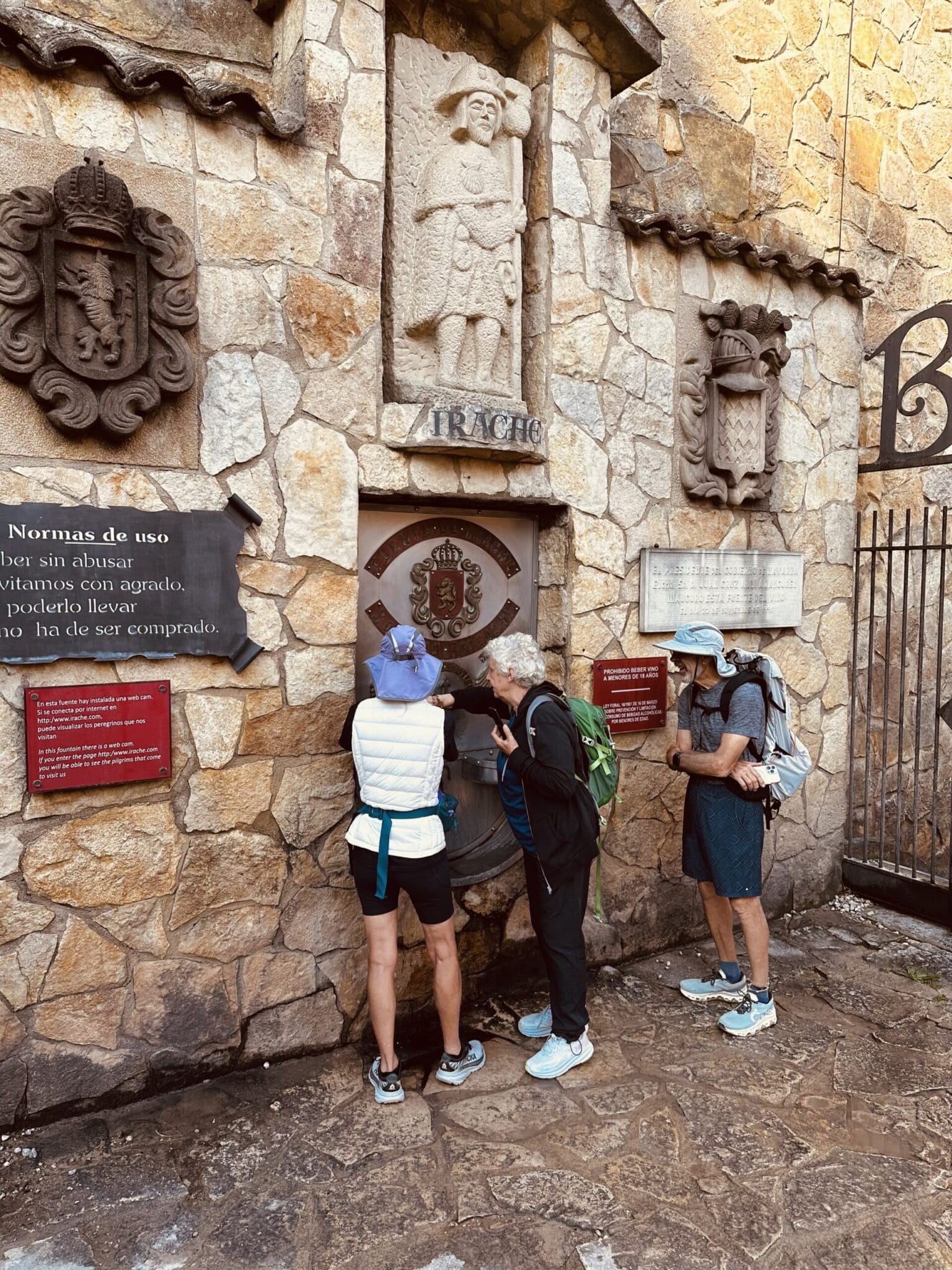
About two kilometres after leaving Estella, you’ll come across one of the Camino’s most famous stops—the wine fountain at Bodegas Irache. Built into a stone wall along the path, it dispenses both water and wine, free for pilgrims. They fill it up fresh every day. Bring a cup or use the shell on your pack.
The fountain sits among the vineyards just before you reach the Monasterio de Irache. You can visit their small wine museum too. There’s even a live webcam on the fountain if you want to wave to friends back home.
Less than 100 metres after the wine fountain, the Camino passes the Monasterio de Irache. Take the time to step in. I found it peaceful—quiet and reflective. Maybe it was the wine, but it stayed with me.
Villamayor de Monjardín
645.5 KM to Santiago
After the monastery, the path begins to climb gently as you head back into the open countryside. Soon, the trail presents a choice. The traditional and more popular route takes you through the village of Villamayor, and the second route takes you through the village of Luquin.
The route via Villamayor de Monjardín offers an incredible view. The village is built on the highest hill in the area, with old castle ruins at the top. You can climb up and take in the panorama —fields, hills, and sky in every direction.
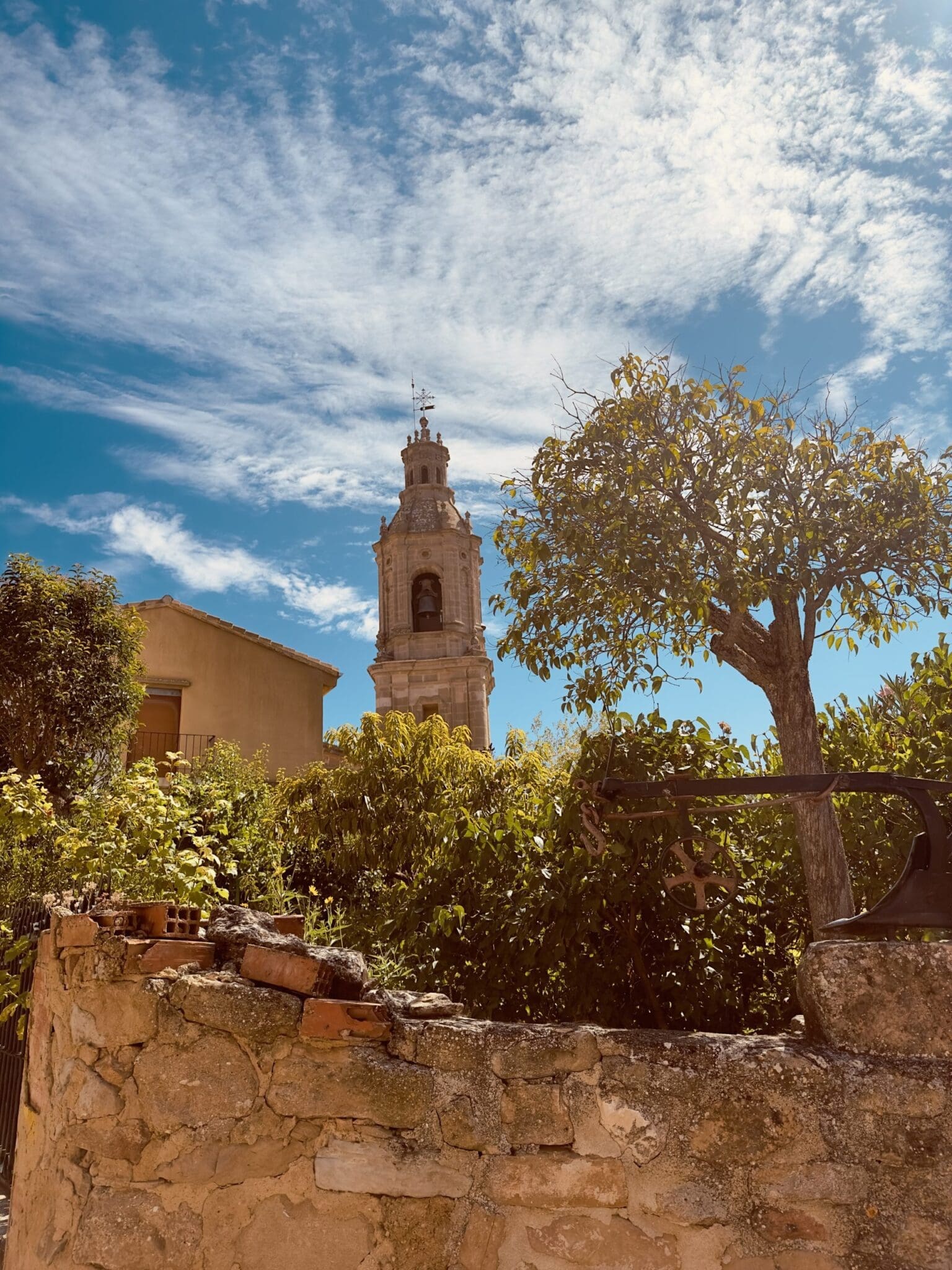
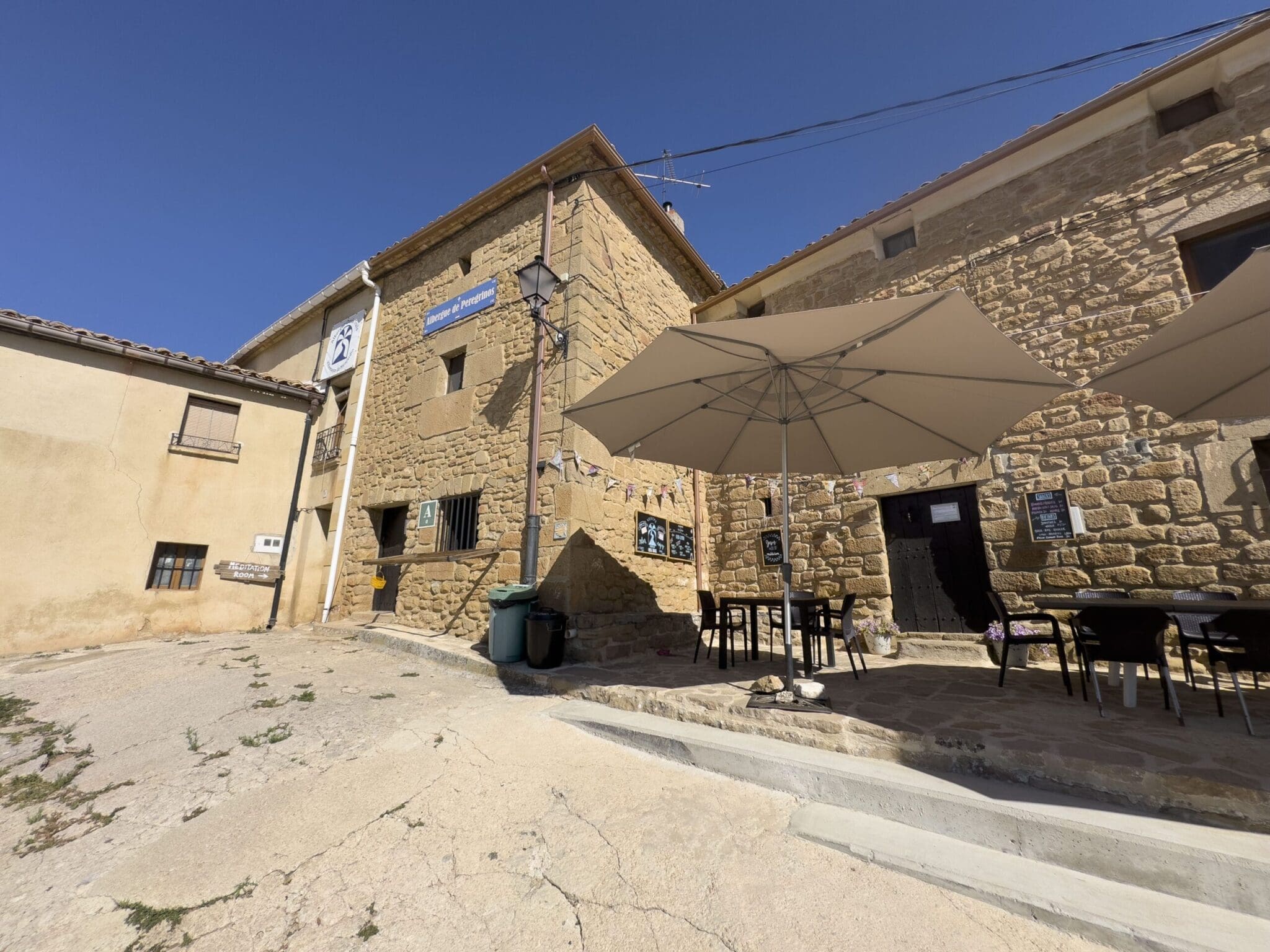
It’s a small place, but there are a few albergues. It can fill up, since the next stretch is 12 kilometers with nowhere to stop. A good place to rest up before the long walk ahead.
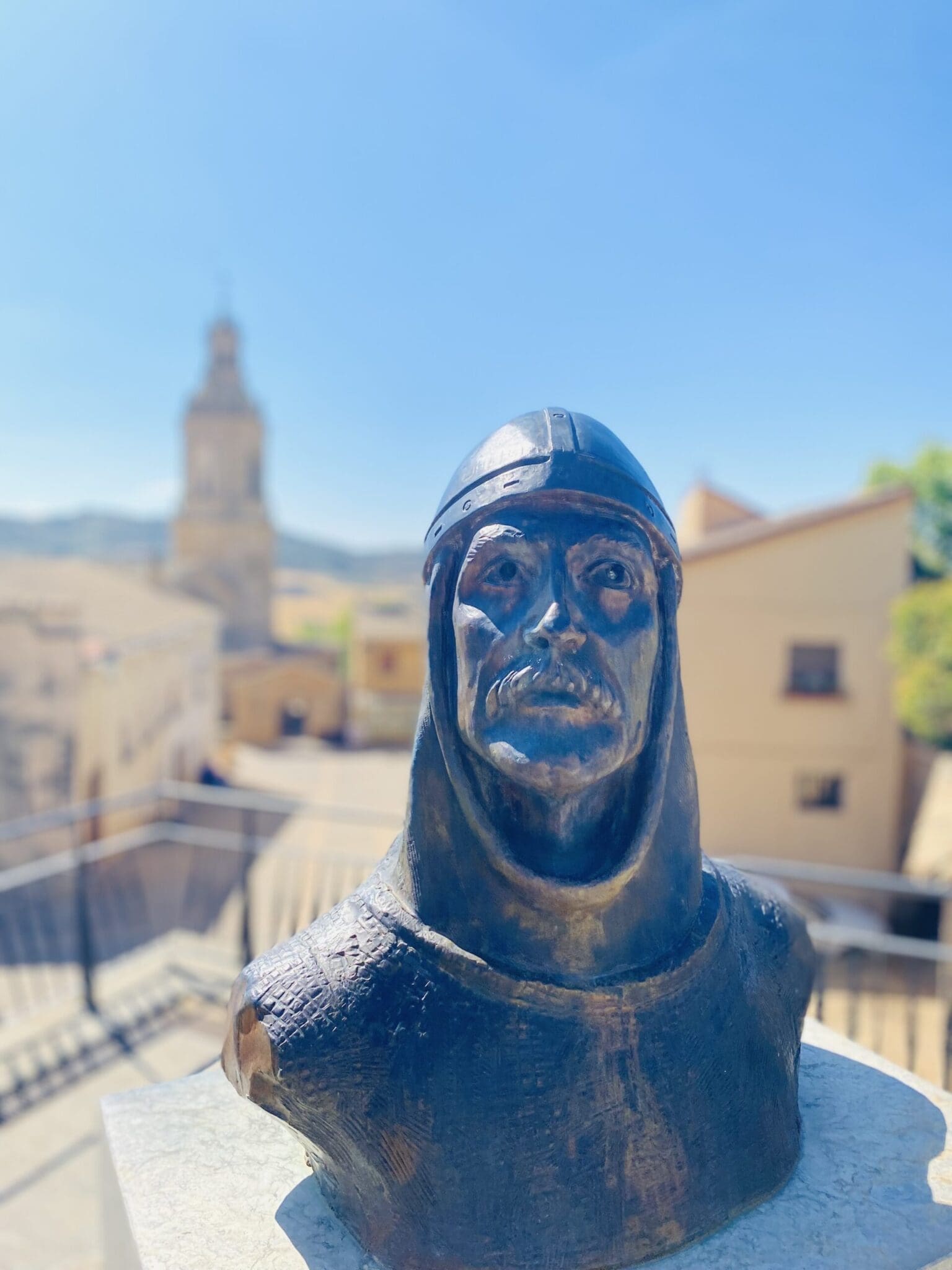
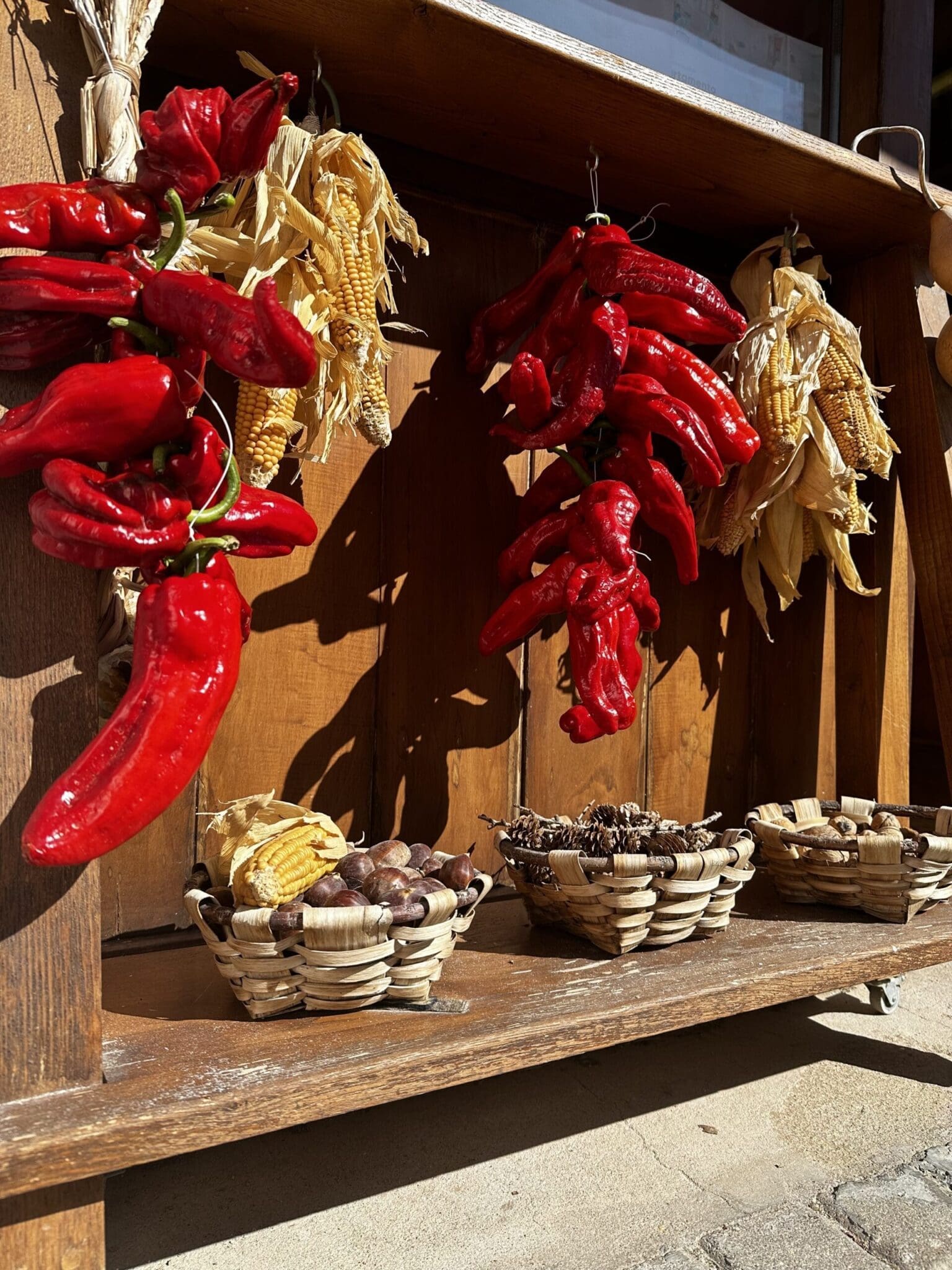
Luquin
644.5 KM to Santiago
The second option is less travelled — a quieter, more intimate detour that takes you through the small village of Luquin. Rather than climbing directly to Monjardín, this route drops gently into more wooded terrain, offering welcome shade and a softer landscape.
It’s the sort of path where birdsong fills the silence, and you might walk for an hour without seeing another soul. Luquin itself is a sleepy little place, almost untouched by time. There’s not much in the way of services, but it feels authentic, as if the Camino has tiptoed through rather than marched past.
After Luquin, the variant rejoins the main route before reaching Los Arcos, and you arrive at your destination with the same dust on your boots but perhaps a different kind of peace in your mind.
Los Arcos
633.8 KM to Santiago
Both paths have their charm. One’s wide and open, full of history. The other’s narrow, shaded, and quiet. Either way, it’s 10 more kilometers to Los Arcos, with nothing in between — no villages, no fountains, no shops. Be ready.
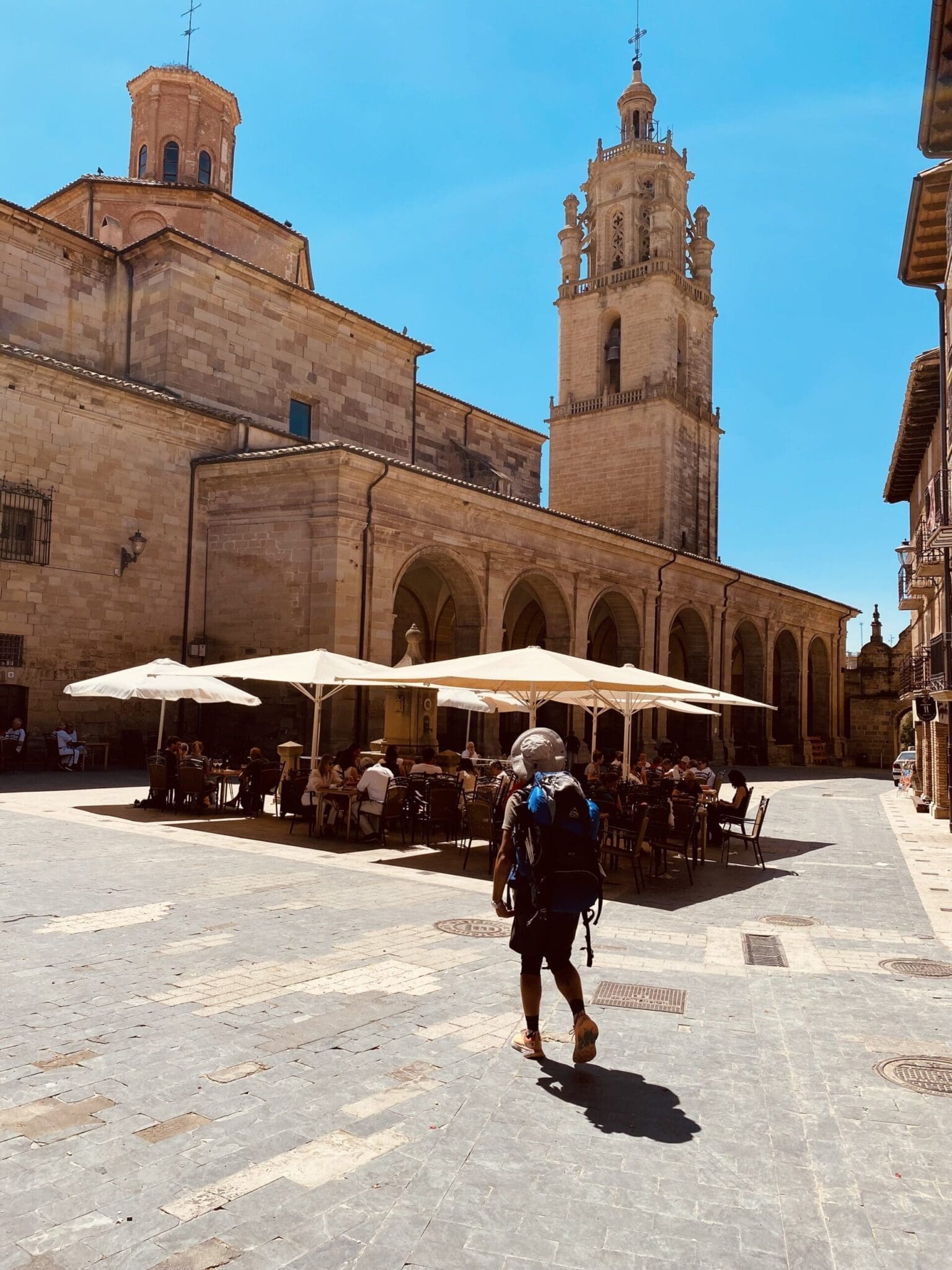
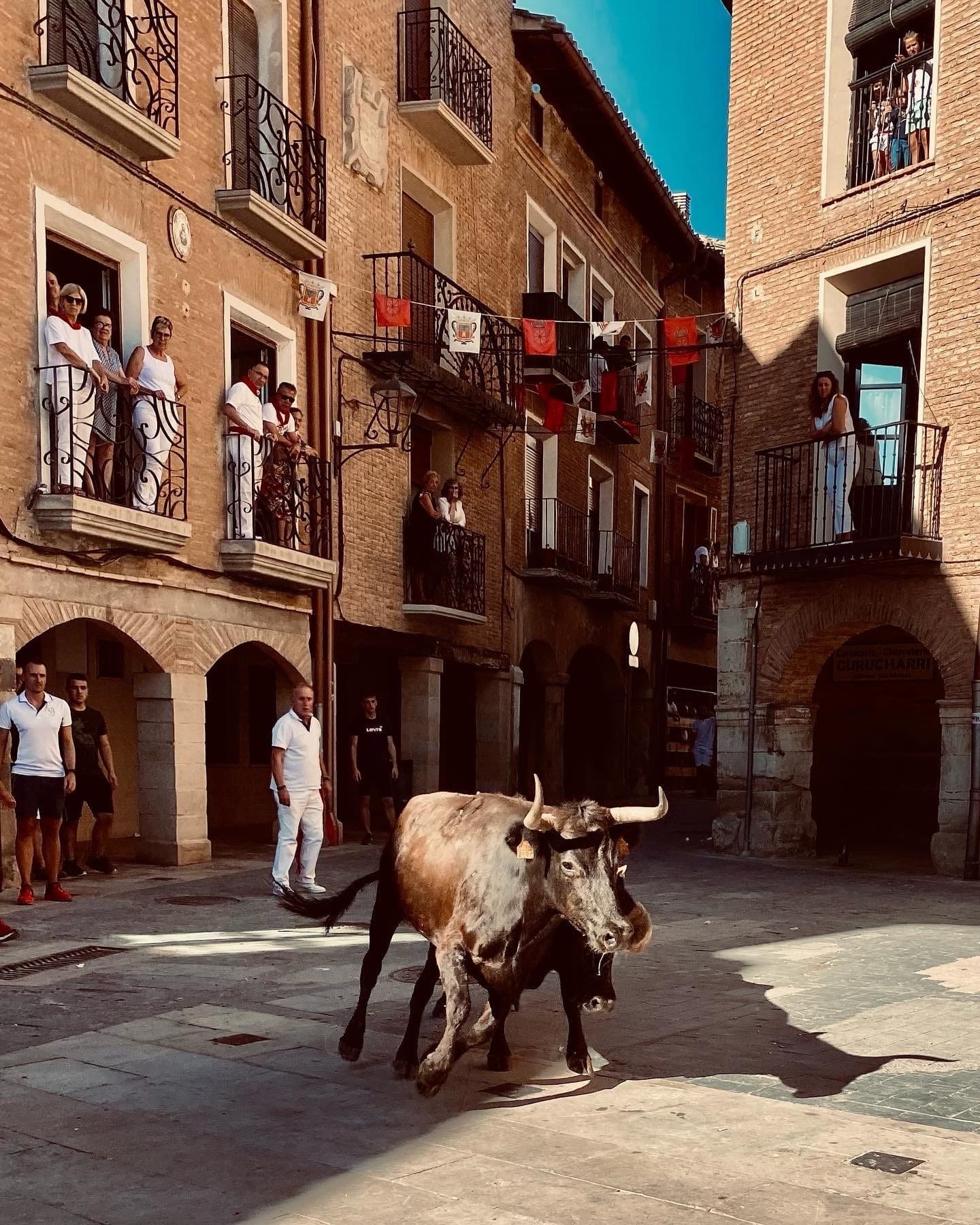
The first time I walked the Camino, I hit the wine fountain. Thought I was clever. Emptied my last bottle of water and filled it with wine. It was blazing hot, and I was already thirsty. A few kilometers later, I was desperate — sunburned, sweating, and dreaming of a miracle to turn my wine back into water. I’d have traded anything for it.
Los Arcos is a classic Camino stop and a popular place to stay. I’ve had some great nights there. One year I somehow ended up in the local bull run — it’s usually in early September. Things get loud and lively.
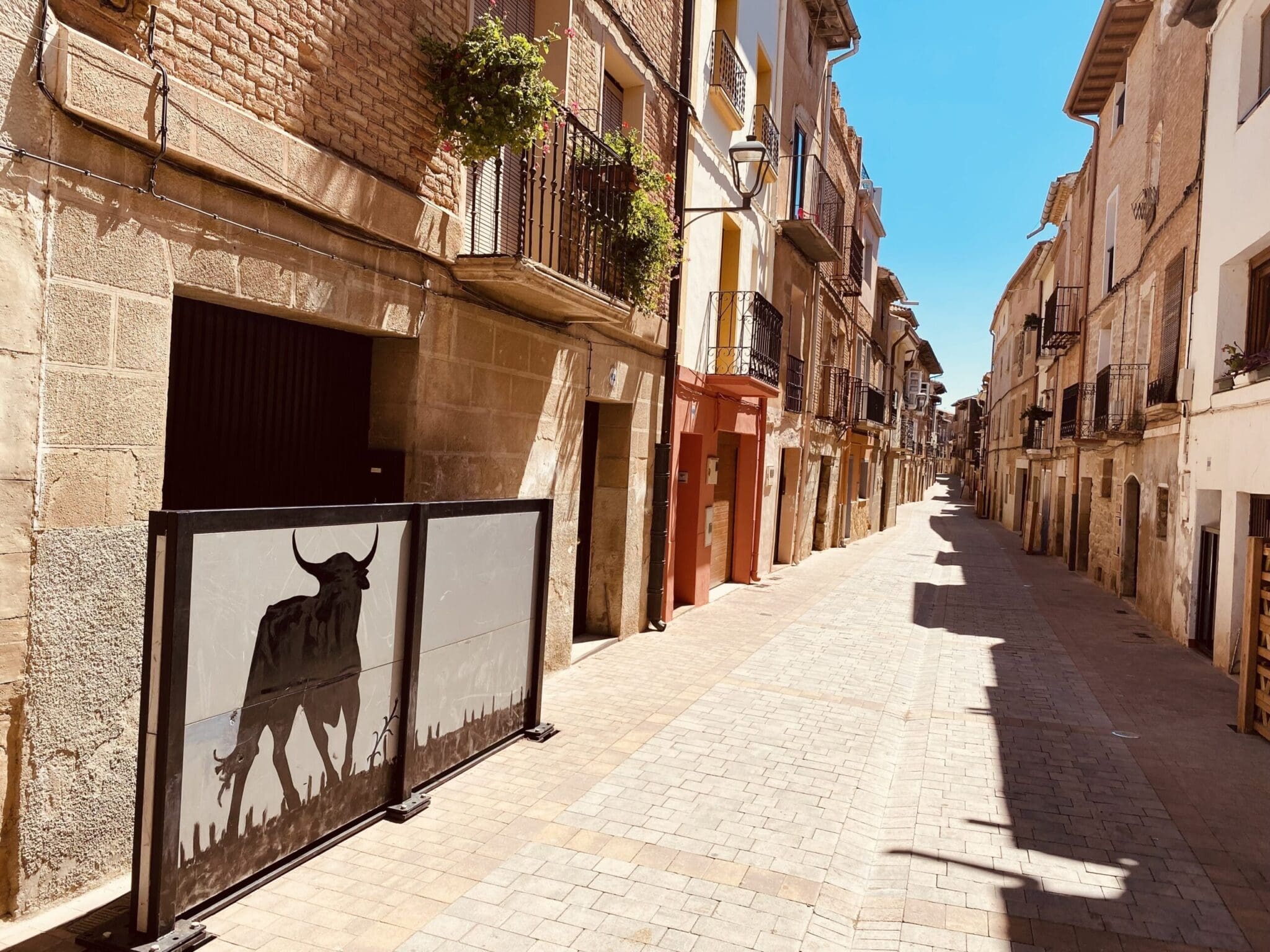
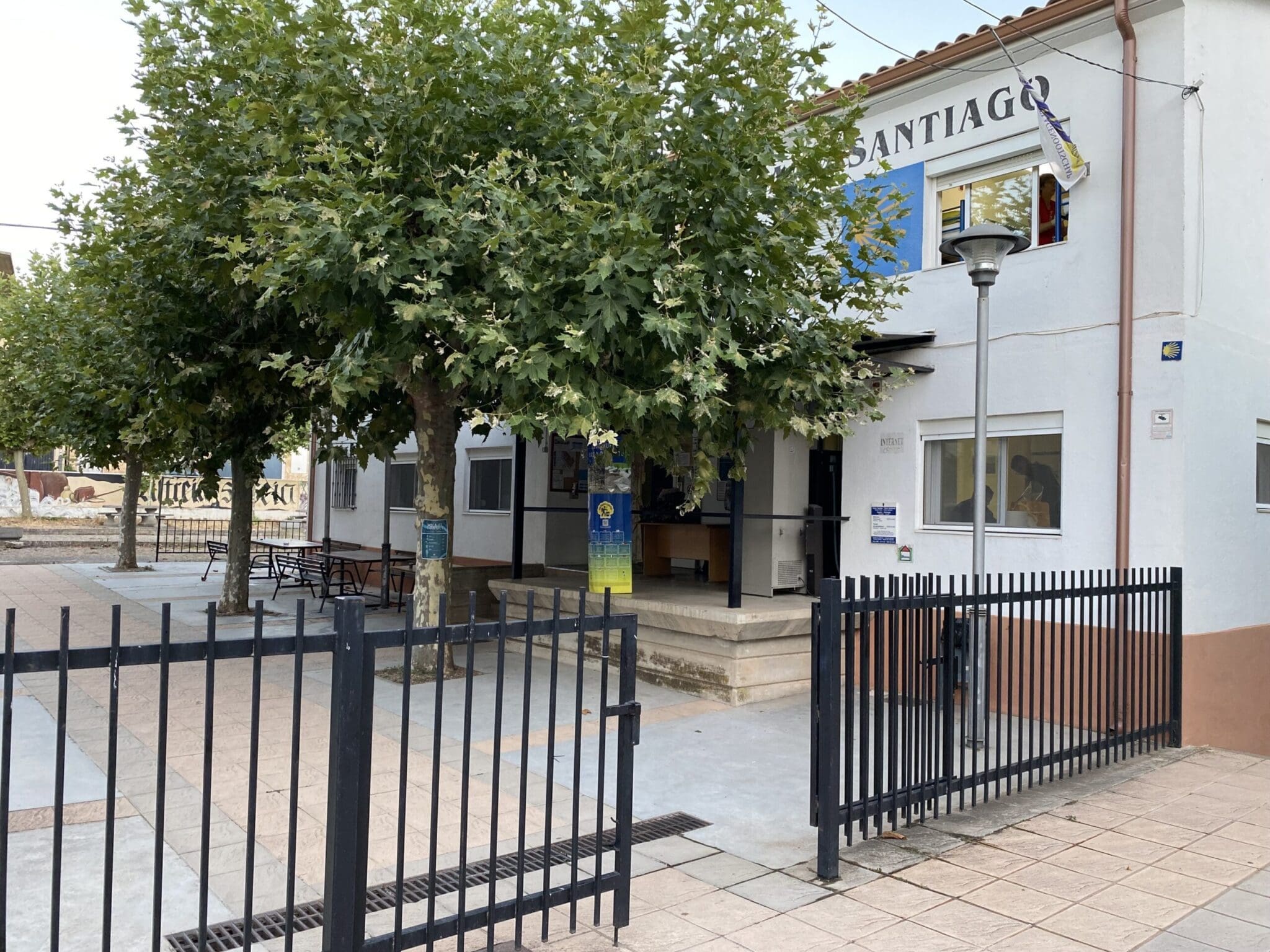
There are plenty of beds. The municipal albergue is just across the main square from where you enter town. It’s busy and full of energy. I also like Albergue La Fuente – Casa de Austria. It’s well run, clean, and the hospitaleros know the Camino.
The square has a few bars and restaurants, and it’s a good spot to sit and watch pilgrims roll in. The main church, Santa María, is worth a visit — it’s big and cool inside, with a huge altar and sometimes organ music in the evening.
Sansol
626.6 KM to Santiago
After Los Arcos, it’s about 7 kilometers to Sansol. Small place, not much going on, but it has one of my favourite albergues on the whole Camino — Albergue Sansol.
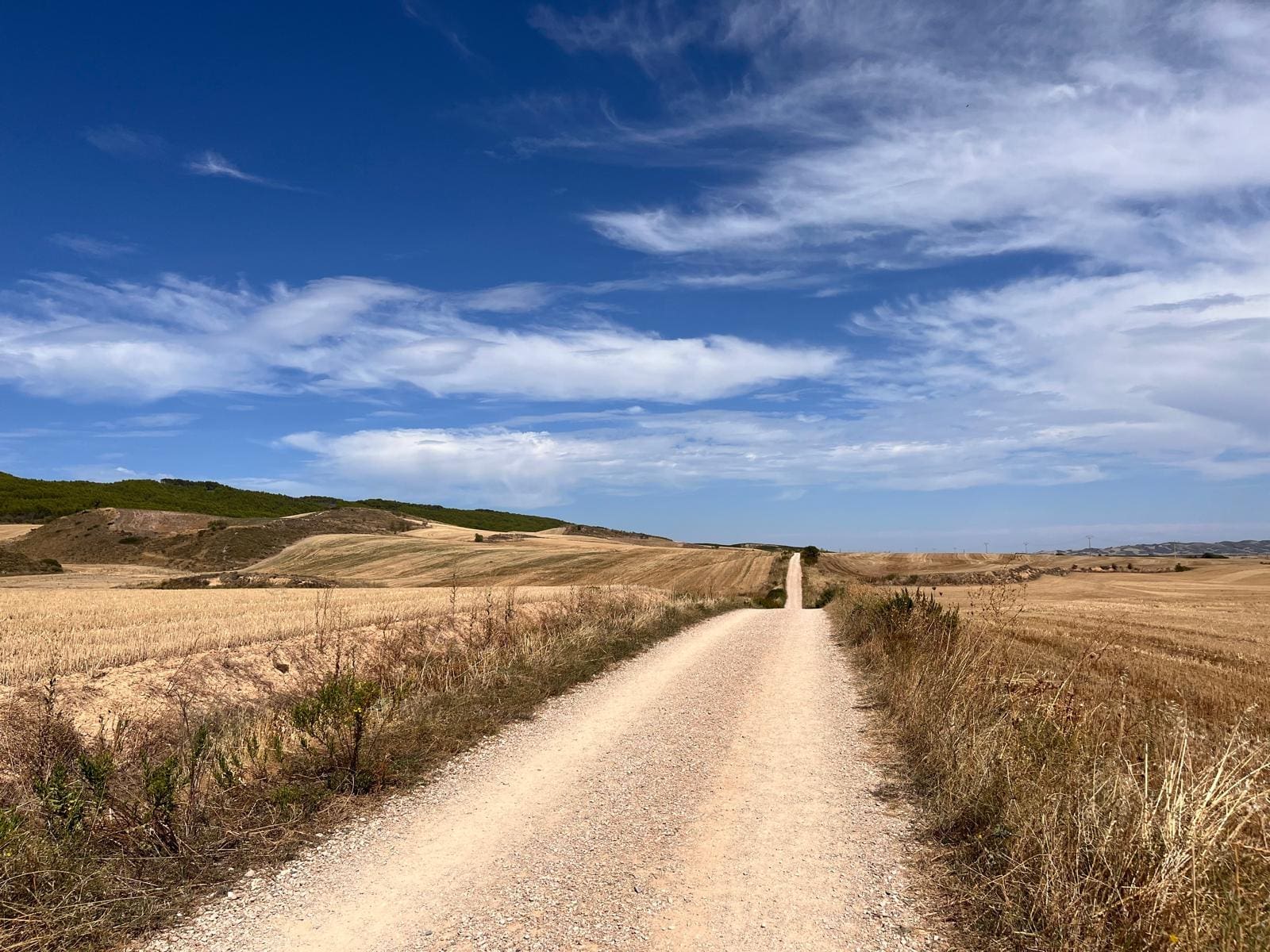
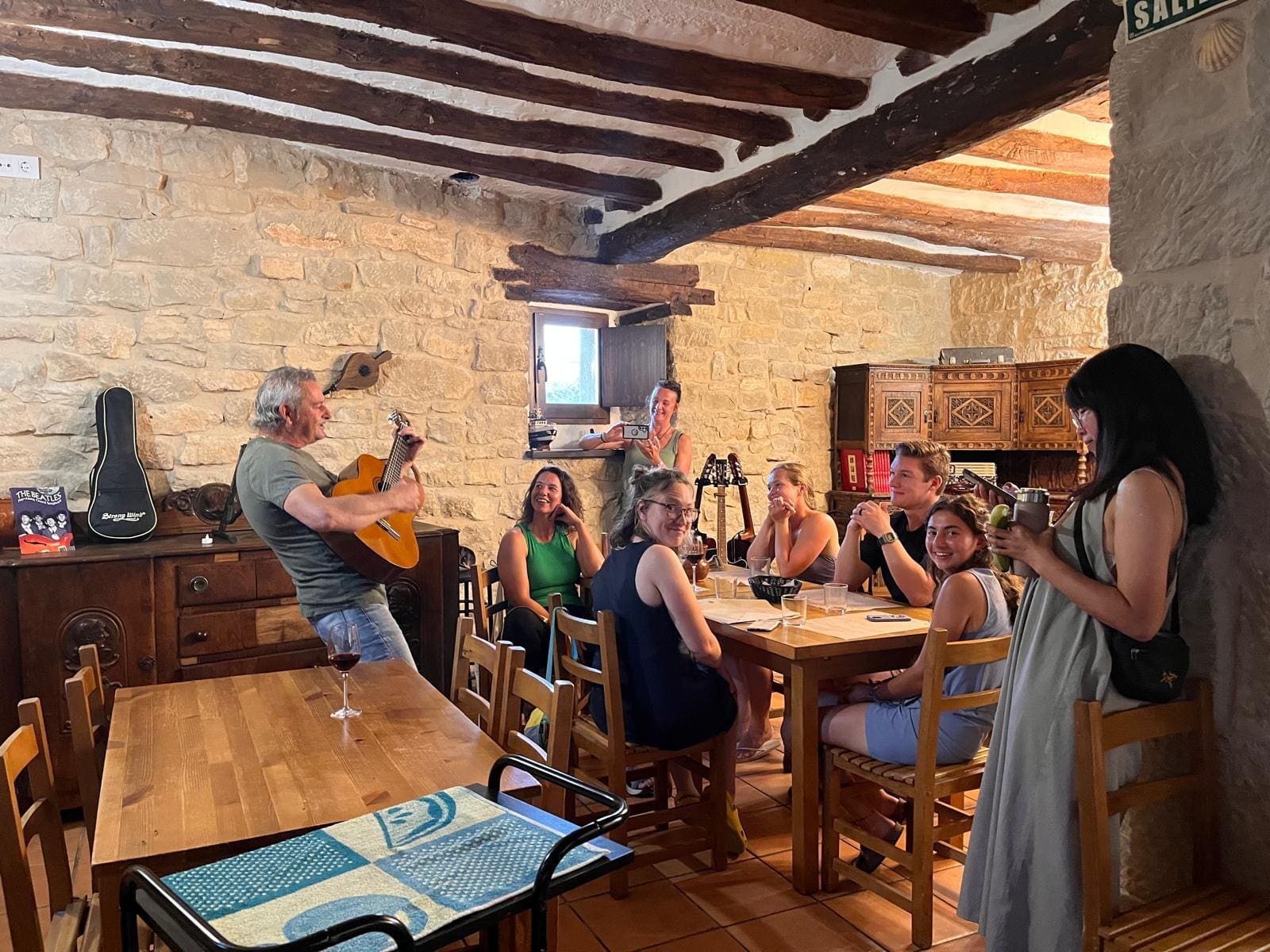
It’s simple and well-run. There’s a fountain out back for soaking your feet, and that turned into the main event. Everyone crowded around, feet in the water, glass of wine in hand. It was hot, we were tired, and it hit the spot.
Later, they served a great communal meal. Big portions, plenty more wine. Someone pulled out a guitar and before long, half the room was singing.
Torres del Rio
625.9 KM to Santiago
Torres del Río is a small hill town with a good Camino feel. The old church is worth a visit, and the views aren’t bad. Albergue Casa Mariela is friendly, affordable, and has everything you need — good food, a bed, and a place to rest your feet.
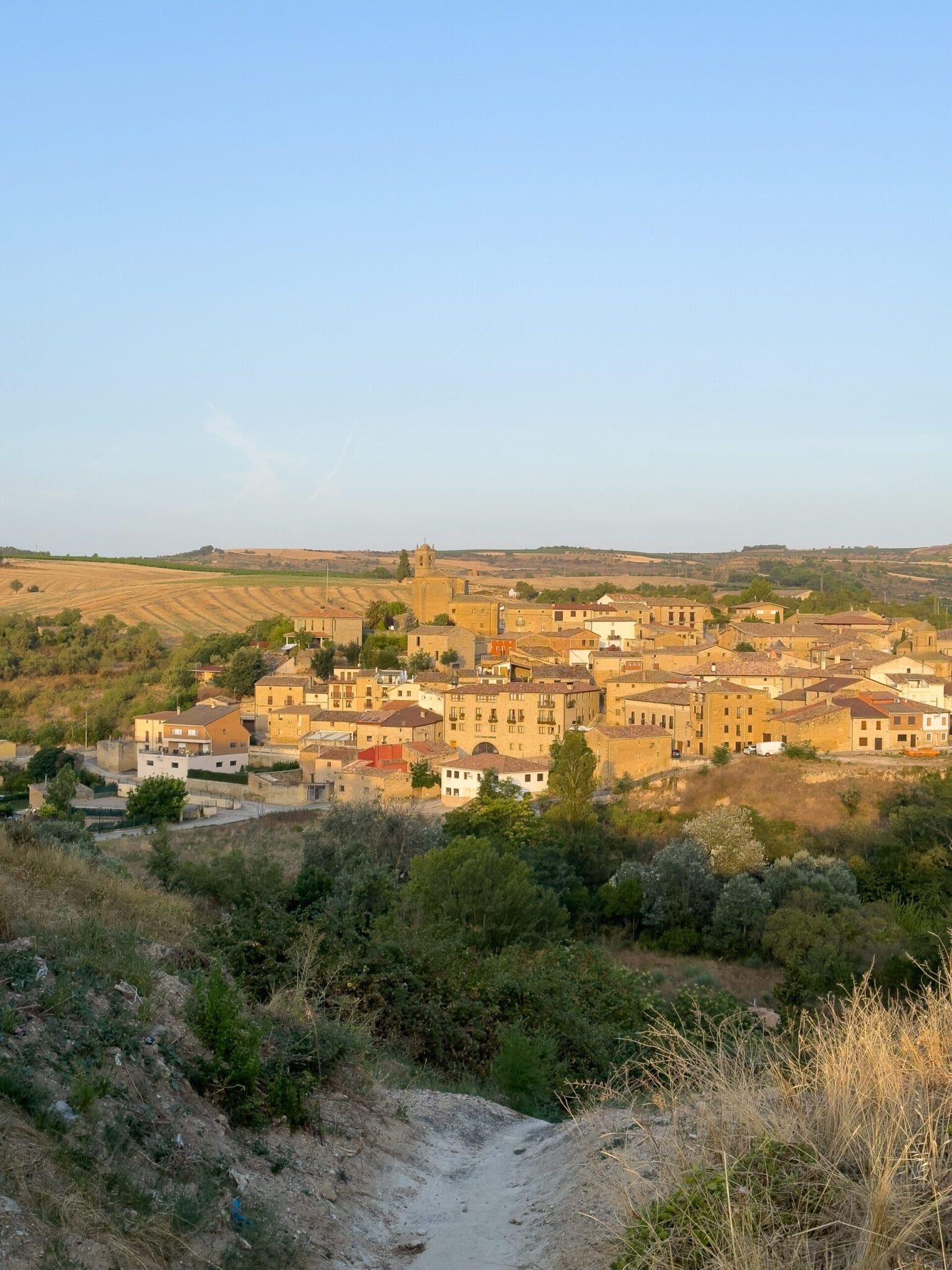
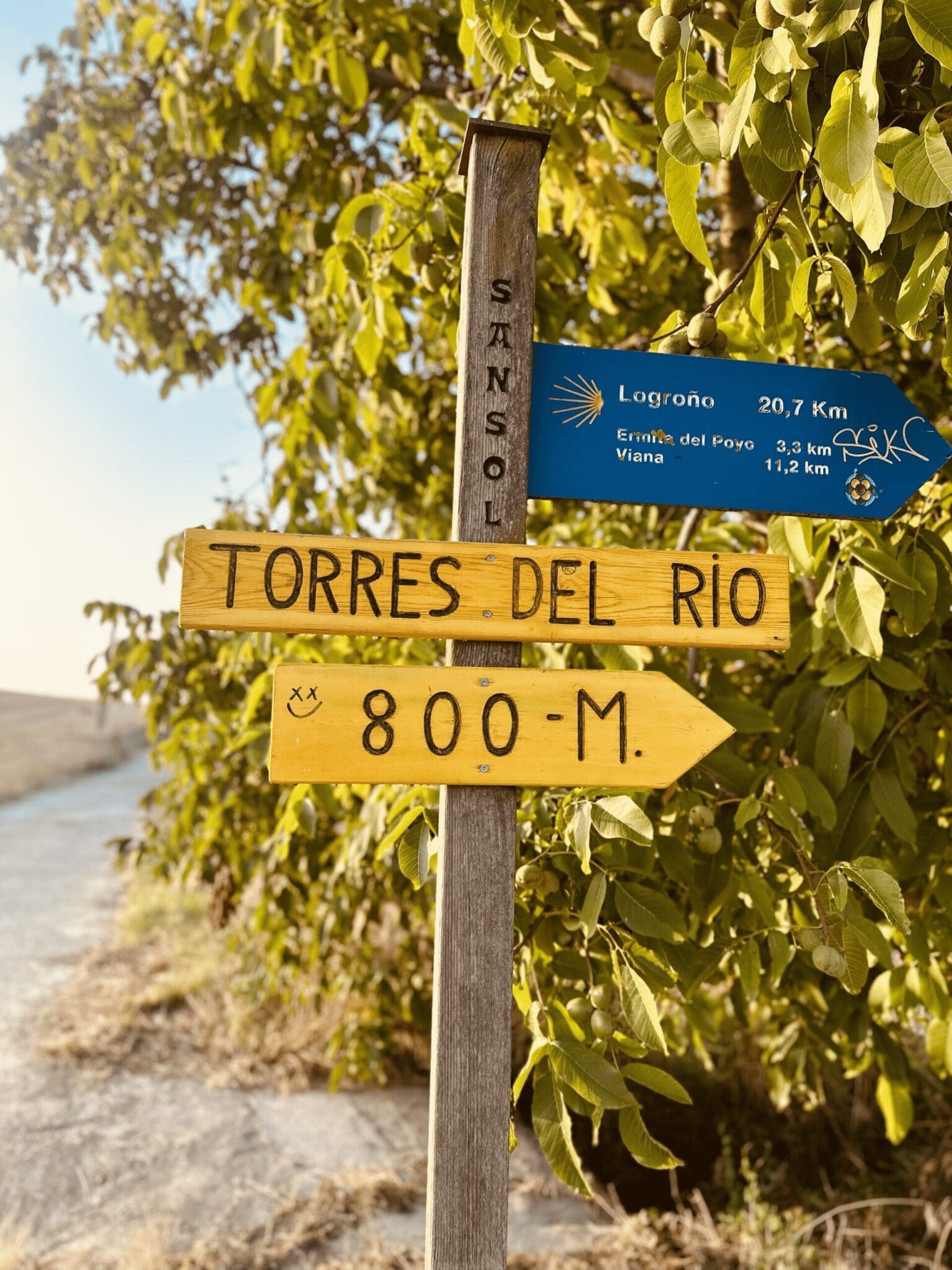
Viana
615.4 KM to Santiago
After Torres del Río, the walk to Viana is about 9 km. Viana is a bigger town with more to offer. I recommend Albergue Izar — clean, modern, and welcoming. They have a kitchen, rooftop terrace, and good communal spaces. It’s a solid place to rest up before heading into Logroño
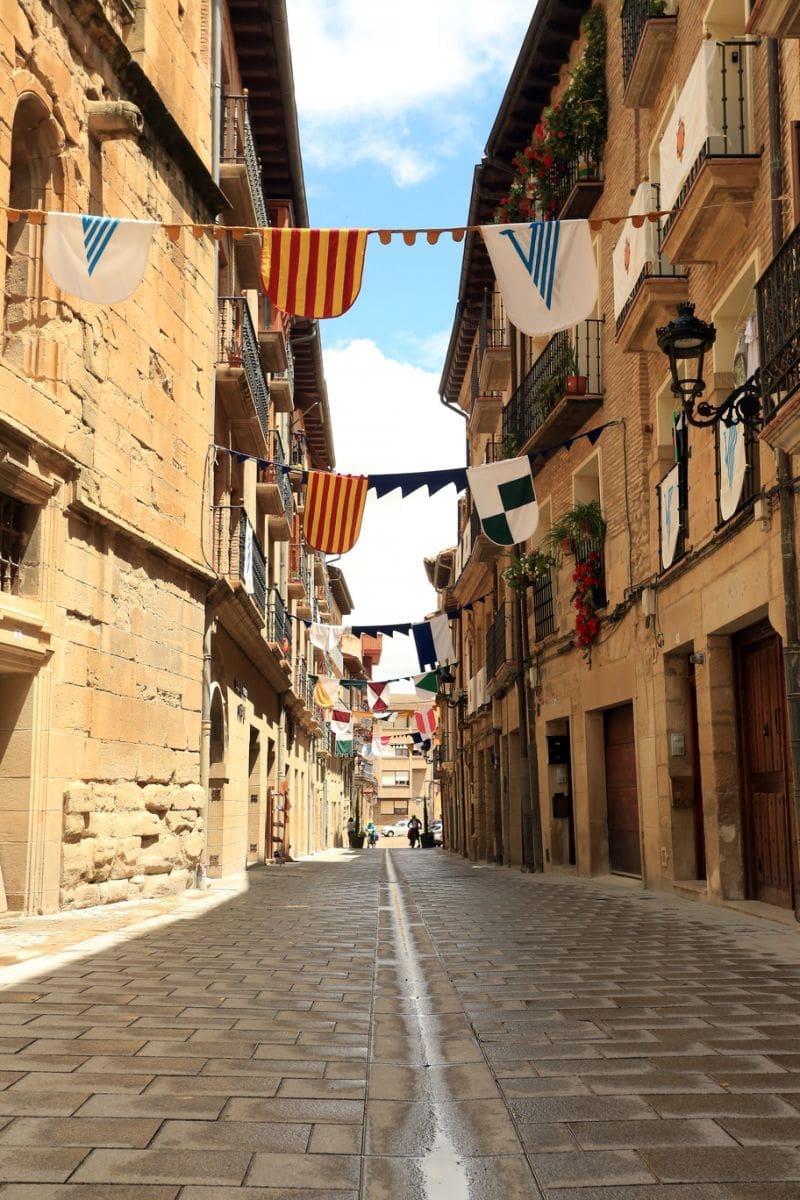
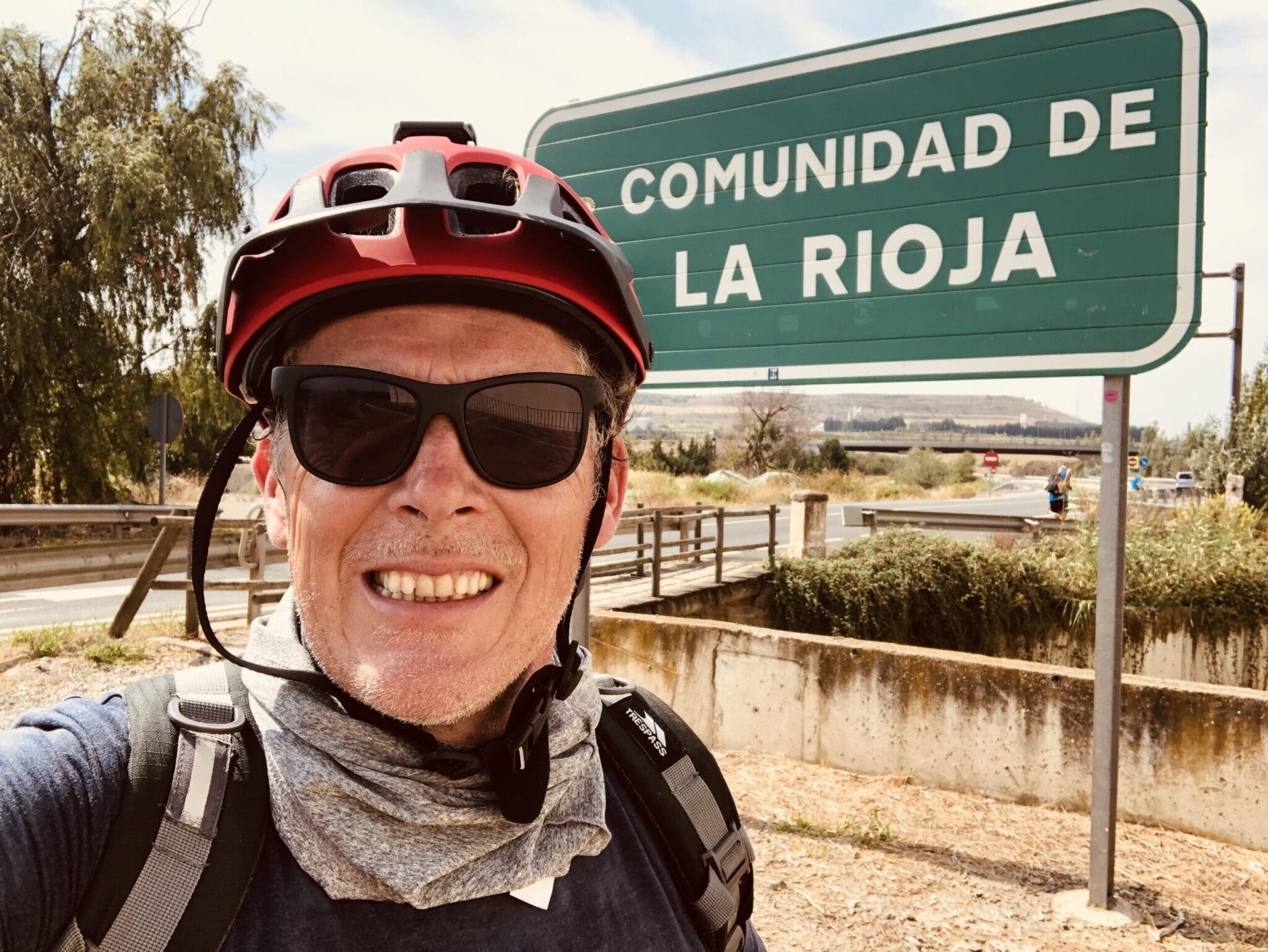
Logroño
605.7 KM to Santiago
The walk from Viana to Logroño is about 9.5 km. You enter the city over the Puente de Piedra, crossing the Ebro.Logroño is a mid-sized city, around 150,000 people, and it feels busy after the quiet villages. The cathedral, Santa María de la Redonda, has a small painting of the Crucifixion attributed to Michelangelo, behind the main altar.
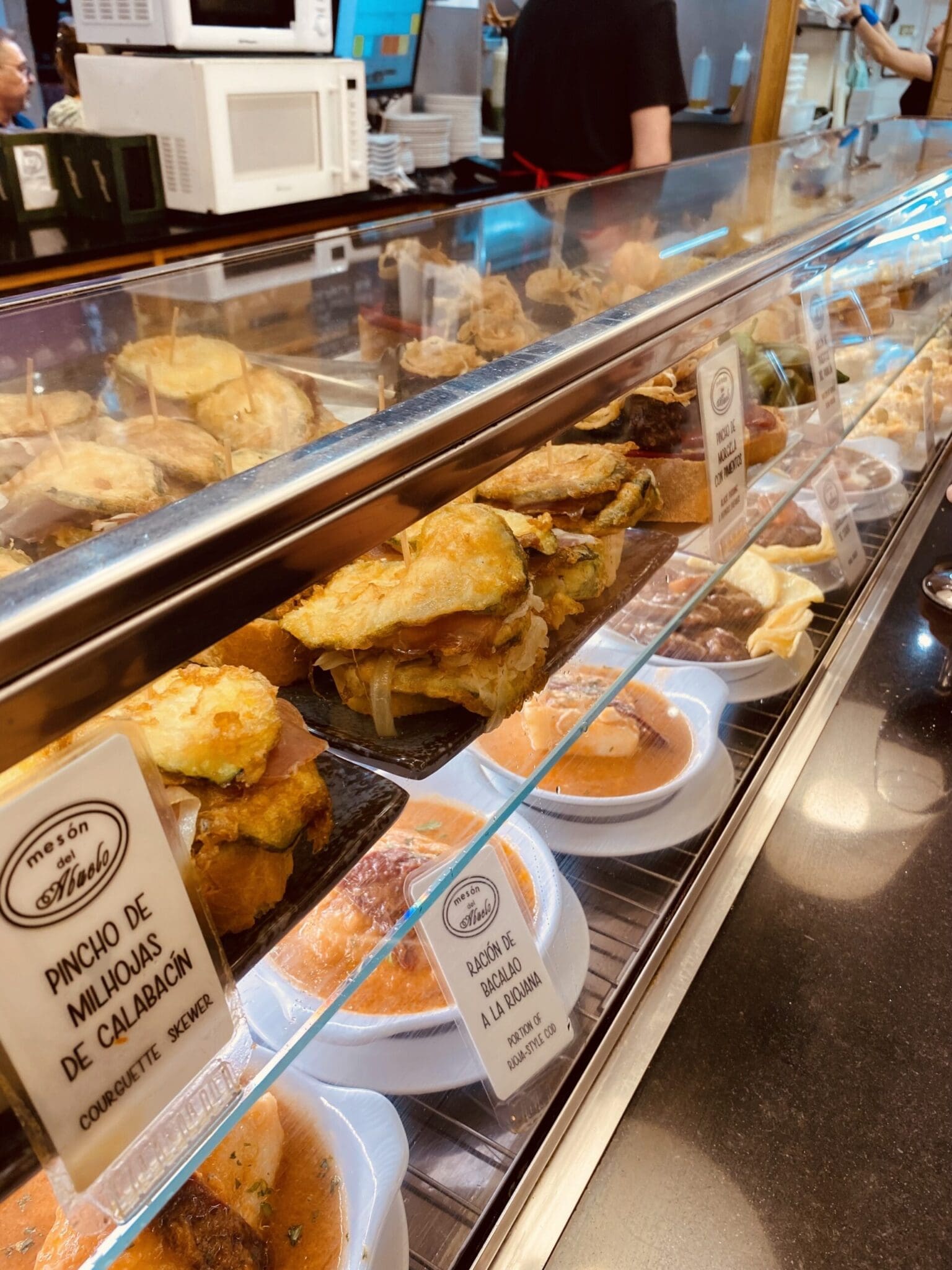
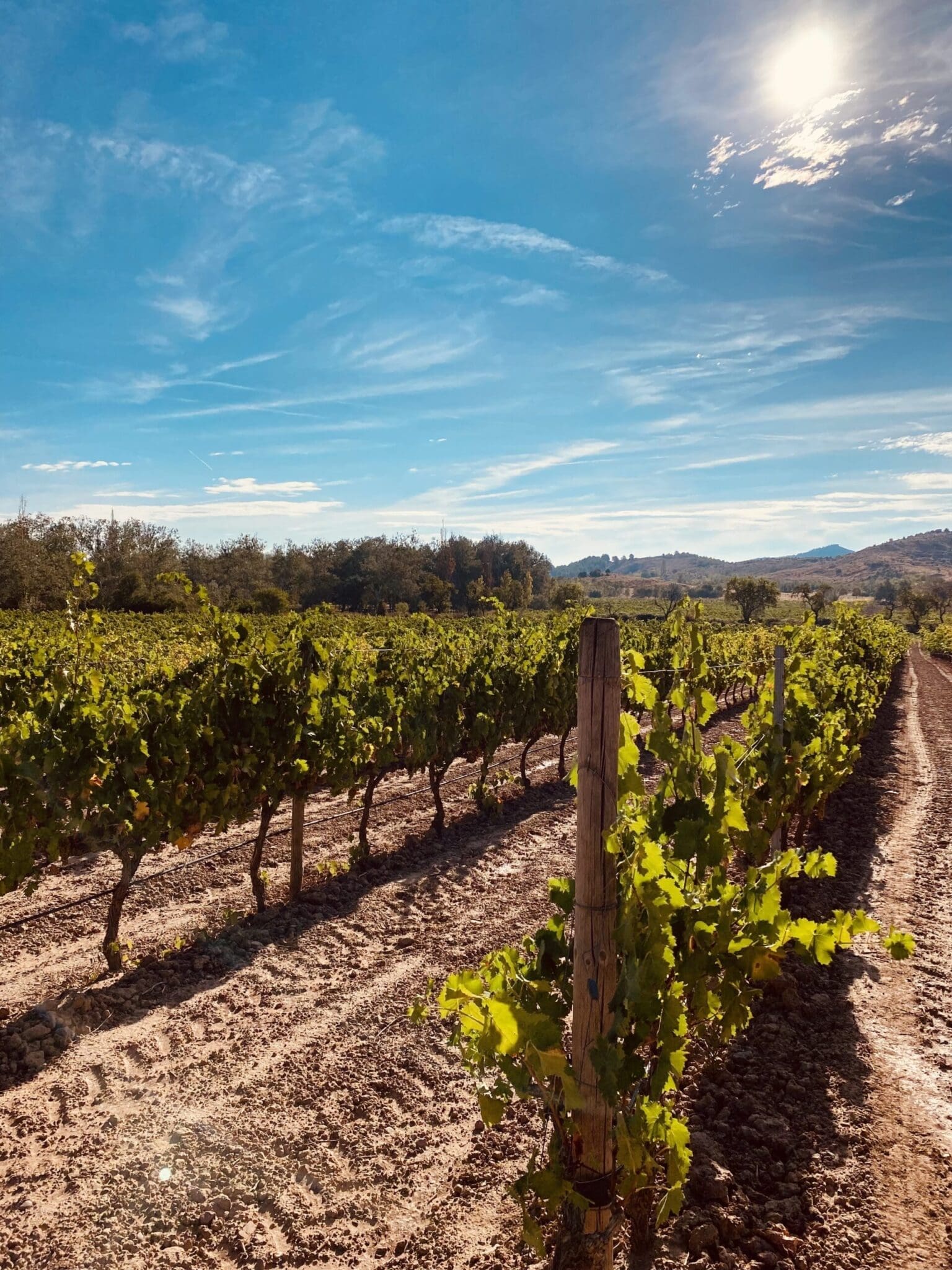
The food scene is strong — Calle del Laurel is packed with bars serving tapas and Rioja wine. I usually stay at the Parroquial Albergue Santiago El Real. It’s donation-based, simple, and right on the Camino.
